If you’ve glimpes at my about page, you’ll know that I’ve been living in Singapore for a very long time – over 15 years! If there is one thing that contributed to my decision to take up Singapore citizenship, it’s that good food can be affordable and is usually never more than a 15-minute cab ride away.
☀️ Visiting Sunny Singapore? Check out my Singapore Travel Guide here, where I have written many information and tips for visiting Singapore!
I have a lot to share on the topic of Singaporean food. It’s going to be a long post, so buckle up.
- What is Singaporean Cuisine like?
- Common Ingredients in Singapore
- What is Hawker Center and which one is good to visit?
- Tips for having the best food experience in Singapore
- What to eat in Singapore
What is Singaporean Cuisine like?
So what do locals actually eat in Singapore?
We often get a lot of flak from our neighbors (looking at you, Malaysians) for not having a dish that is uniquely Singaporean. While that may be true, I’d like to take pride that Singapore is one of the few places in the world where you can sample a great variety of cuisines with decent quality and authenticity.
Much of the typical food you’ll find in Singapore draws from its melting pot origin. You’ll often find influences from China (particularly Hainan, Cantonese, and Hakka), Malaysia, Indonesia, and India, or even fusions among several countries. To me, Singapore food tells an interesting history of how the country came to be.
Common Ingredients found in Singapore
In general, you will find the following ingredients present in many local fares:
- Coconut Milk – Usually found in sauces, broth, curry, or to cook rice in to give it extra flavor.
- Pandan – I’d like to think this is our version of vanilla! It gives dishes this sweet aroma very similar to how people use vanilla.
- Chili – No self-respecting Southeast Asia country will leave out chili from their dishes!
- Prawn Paste – As someone who dislikes crustaceans, I have to give credit to prawn paste for enhancing the flavor of many dishes.
- Ikan Bilis – This dried fried anchovy is an umami bomb and a texture boost. Often used for toppings as extra salty crunch or to flavor soup broths.
What is a Hawker Center and which one is good to visit?
Back in the days, just like other Southeast Asian countries, Singapore had its own street food scene. But without access to running water and proper drainage, street food vendors became a health hazard. In a bid to improve hygiene and quality of life, the Singapore government banned street stalls and gradually moved food vendors into dedicated food centers with access to running water, proper drainage, and ample space for cooking. These food centers are now known as Hawker Centers.
These days, Hawker Center is an open-air, non-air-conditioned food center that you can find very commonly in Singapore. They’re known for serving up cheap but tasty food. Most of the dishes I’m listing in this post are known as “hawker food”.
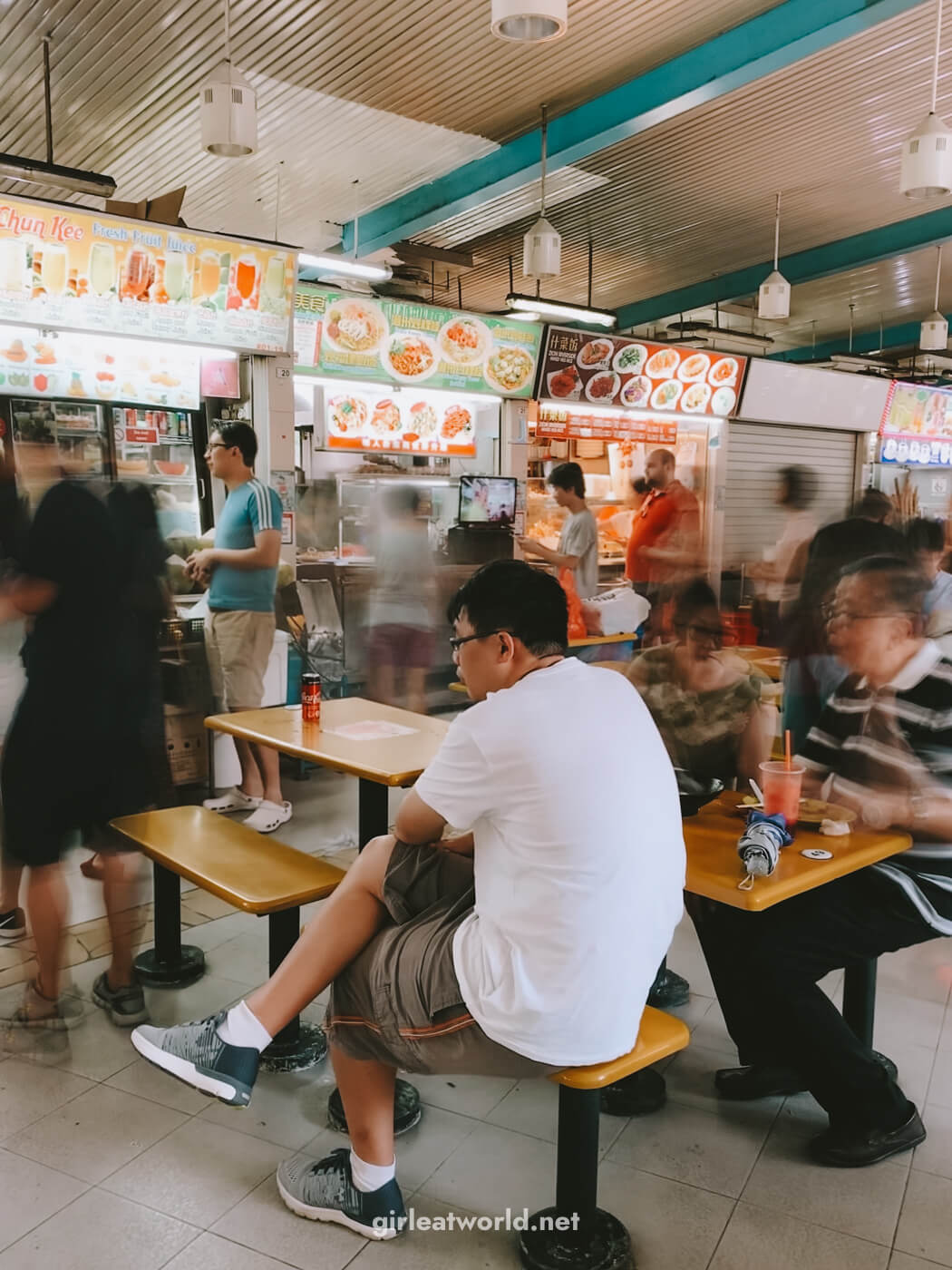
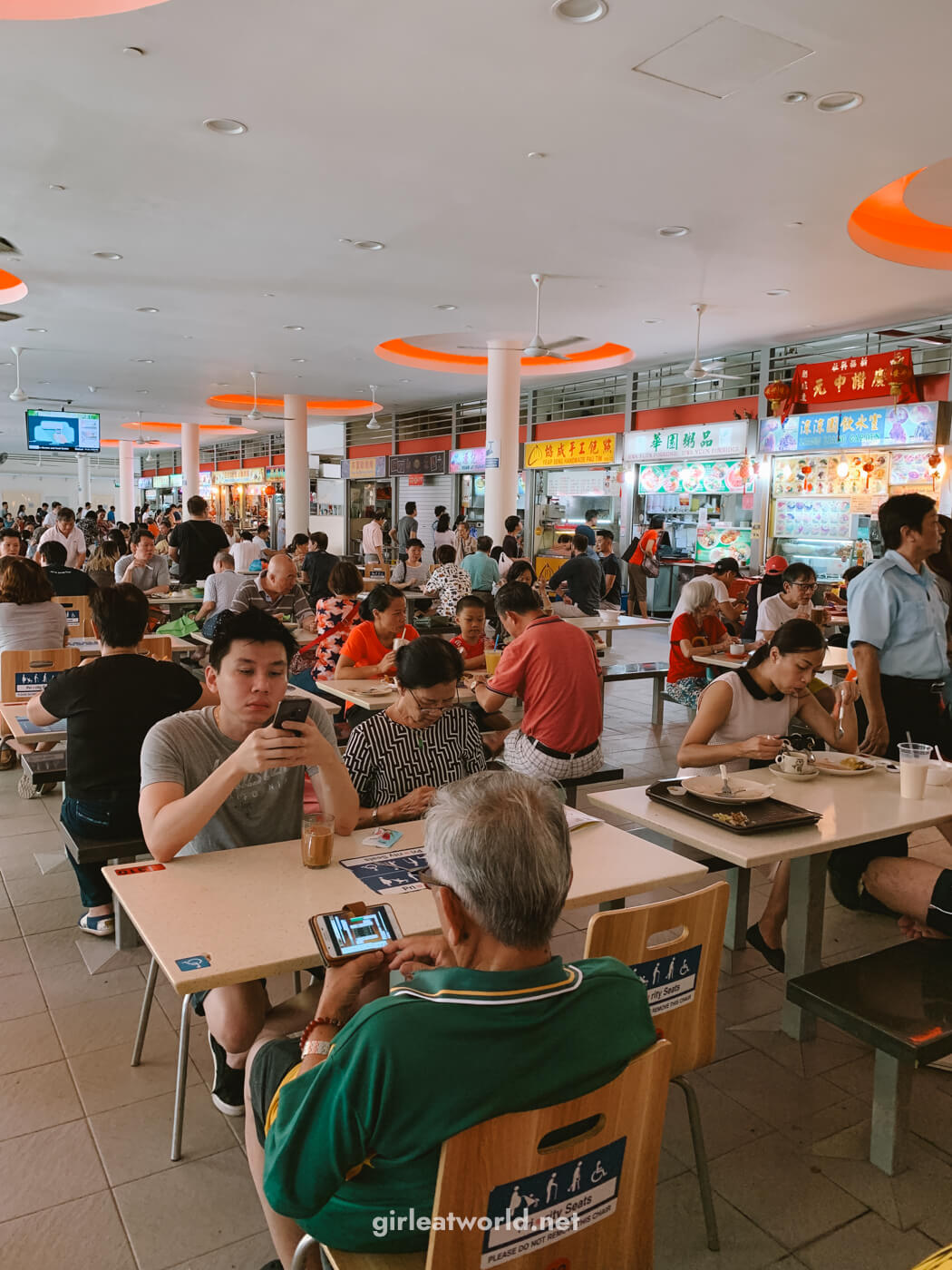
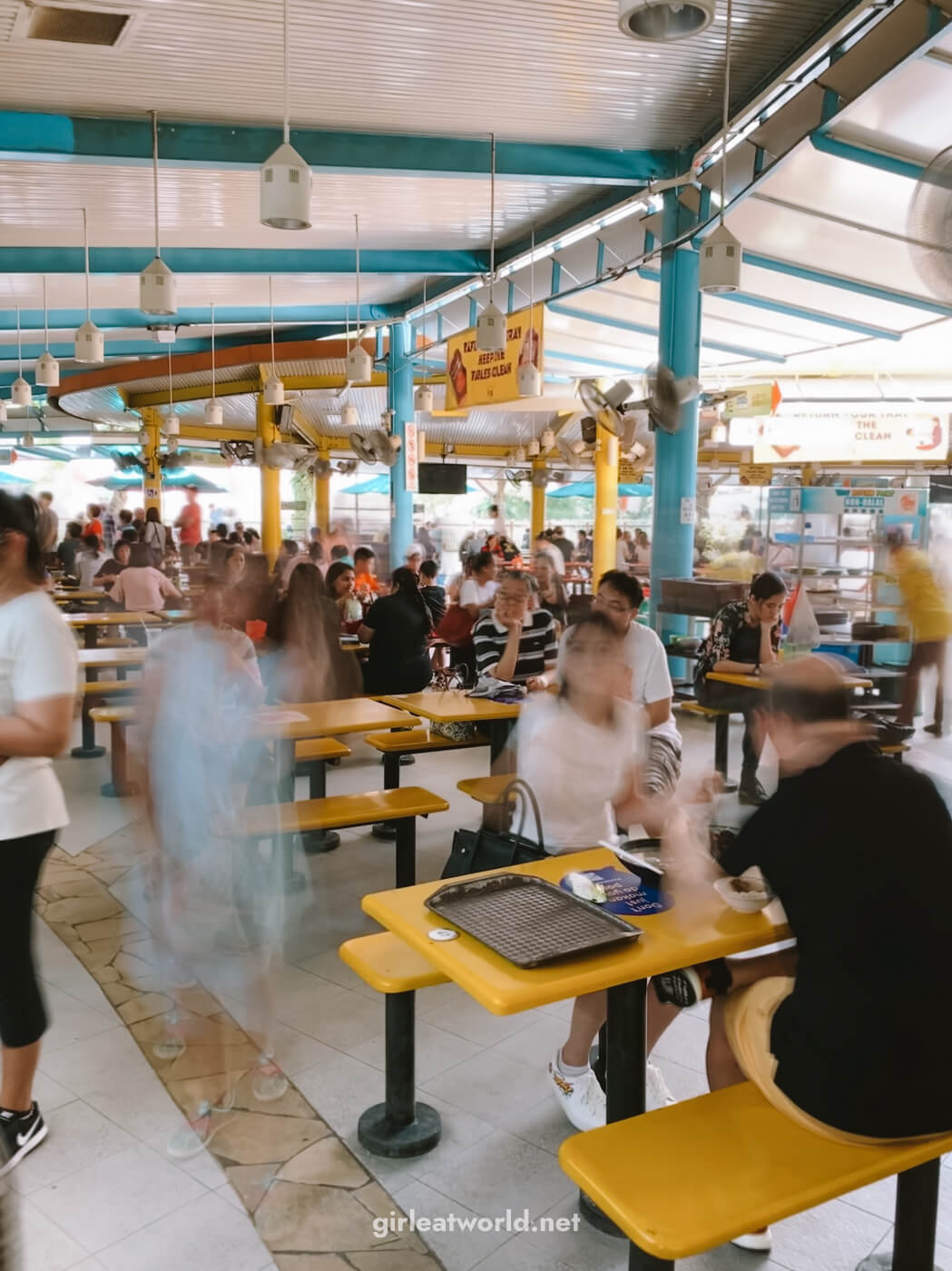
Because of how affordable and convenient these food centers are, eating out has become a culture in Singapore. You don’t need to cook at home if you don’t want to, just head down from your apartment and find the nearest food center.
Here are some of my favorite food centers. You’ll find them making an appearance in my food recommendations.
- Bendemeer Food Center – A lesser-known food center away from the tourist area, but loved by locals as they host some of the best local food stalls.
- Lau Pa Sat – Singapore’s oldest wet market converted to a hawker center, many think Lau Pa Sat is too touristy. But for me, they still serve pretty good food and you can’t beat the convenient location. Worth a visit!
- Chinatown Complex Food Center – Located just a stone-throw away from Chinatown MRT, this is one of the earliest hawker centers to be built in Singapore.
- Tiong Bahru Market Food Center – Convenient for tourists as it is close to Tiong Bahru MRT, this food center is built on top of a wet market. It is also one of the first hawker centers to operate in Singapore.
- Old Airport Road Blk 51 Food Center – This hawker center was built in 1972 and has become an icon for Singapore.
- Food Republic Food Center – Food Republic is a prime example of a modern hawker center. It is usually located in an air-conditioned shopping mall, but it still has a good variety of stalls and great food. Locations can be found here.
Check for closures before you go: Occasionally, a hawker center might be closed for cleaning or renovation. Please check here for the closure notice before you head out!
Tips for having the best food experience in Singapore
Avoid the Chinese New Year (CNY) period – With the majority of the country being of Chinese descent, CNY has a strong effect in Singapore. Many hawker stalls I mentioned below will close in the week around CNY. For example in 2024, the official CNY Public Holiday was only from 10 to 12 February but many food stalls closed from 8 to 16 February.
Understand the etiquette for visiting hawker centers – If you see a tissue packet (or any other item like an umbrella or business card) on the table, that table has been “reserved”. During peak hour, it is not uncommon to share a table with strangers – just check that they aren’t reserving space for others.
Put back your tray – After you are done eating, put back your trays and used plates in the proper place. Pay attention if the stall you ordered from was halal vs non-halal, since the tray return would be separated. If not, you might experience another Singapore special – you might get fined (yes, really 😆)
Payment Methods – For non-residents hoping to dine in hawker centers, cash is still king. While Singapore has mostly adopted digital payment methods, some of them (PayNow) are only available to residents with a local bank account. If you want to pay by credit card, try to see if the Grab or Fave app works for you, as it allows you to charge a credit card through the app. But always fall back on cash, because most stalls are not yet accepting Grab or Fave as payment methods.
Need Halal food? No problem! There is a large Muslim population in Singapore and the halal industry is regulated. Look for a halal certification in the hawker stalls and restaurants you want to visit. Or, you could even search a list of halal-certified establishments here – If you provide a building name or address, you’ll get the list of all the halal-certified establishments in that building.
Are you vegetarian or vegan? While having dietary restrictions could limit your choices, I think Singapore is still fairly vegetarian-friendly. One of my favorite vegetarian meals is South Indian food and it is one of my favorite cuisine. I suggest checking out restaurants like MTR 1924 in Little India for some of the most delicious masala dosa you’ll ever have. If you want a nicer restaurant, try to get a reservation at Podi & Poriyal just down the street. If you want something more local, try Buddhist vegetarian cuisine at Lian Xin in Buddha Tooth Relic Temple. For general restaurants, I enjoyed Real Food – their baked rice and dumpling soup are my favorites.
Hawker Center temporary closures – Occasionally, a hawker center might be closed for a few days for cleaning or a few months for renovation work. To avoid any disappointments, please check here for the closure notice before you head out!
Account for the ++ when dining in a restaurant – While the price of most retail goods in Singapore already includes tax, it’s a different story for dining in a sit-down restaurants. Most of the time, the price indicated are not inclusive of GST and service charge. If it does have ++, it means you will be charged 9% for GST and 10% for service charge. But again, this only applies to sit down restaurant where the food will be served to you. It does not apply to hawker centers or fast food type of place.
What to eat in Singapore
And now that you’re well equipped with information about food in Singapore, here is my long list of local food that I truly love, along with my personal recommendations! This is where I would send my family and friends when they’re visiting.
- Traditional Singaporean Breakfast
- Hainanese Chicken Rice
- Yong Tau Foo
- Bak Kut Teh (Pork Ribs Soup)
- Ice Cream Sandwich
- Chili Crab
- Chai Tow Kway (Carrot Cake – the savory kind!)
- Orh Luak (Oyster Omelette)
- Char Kway Teow (Fried Rice Noodles)
- Peranakan Cuisine
- Laksa
- Nasi Lemak
- Nasi Biryani
- Hakka Lei Cha Fan (Thunder Tea Rice)
- Ban Mian (Handmade Noodles)
- Bak Chor Mee (Minced Pork Noodles)
- Wanton Mee
- Dim Sum
- Min Jiang Kueh (Peanut Pancake)
- Hainanese Beef Noodles
- Cai Png (Mixed Vegetable Rice)
- Chee Cheong Fun (Rice Noodle Rolls)
- Cantonese Roast Meat Rice
- Nasi Padang (Halal-friendly)
- Sliced Fish Soup
- Fish Ball Noodles
- Beef Horfun
1. Traditional Singaporean Breakfast
Start your day with breakfast loved by all Singaporeans! A breakfast set in Singapore usually consists of Kaya Toast with cold butter, accompanied by two soft-boiled eggs and a cup of local Kopi (the local way of saying “coffee”).
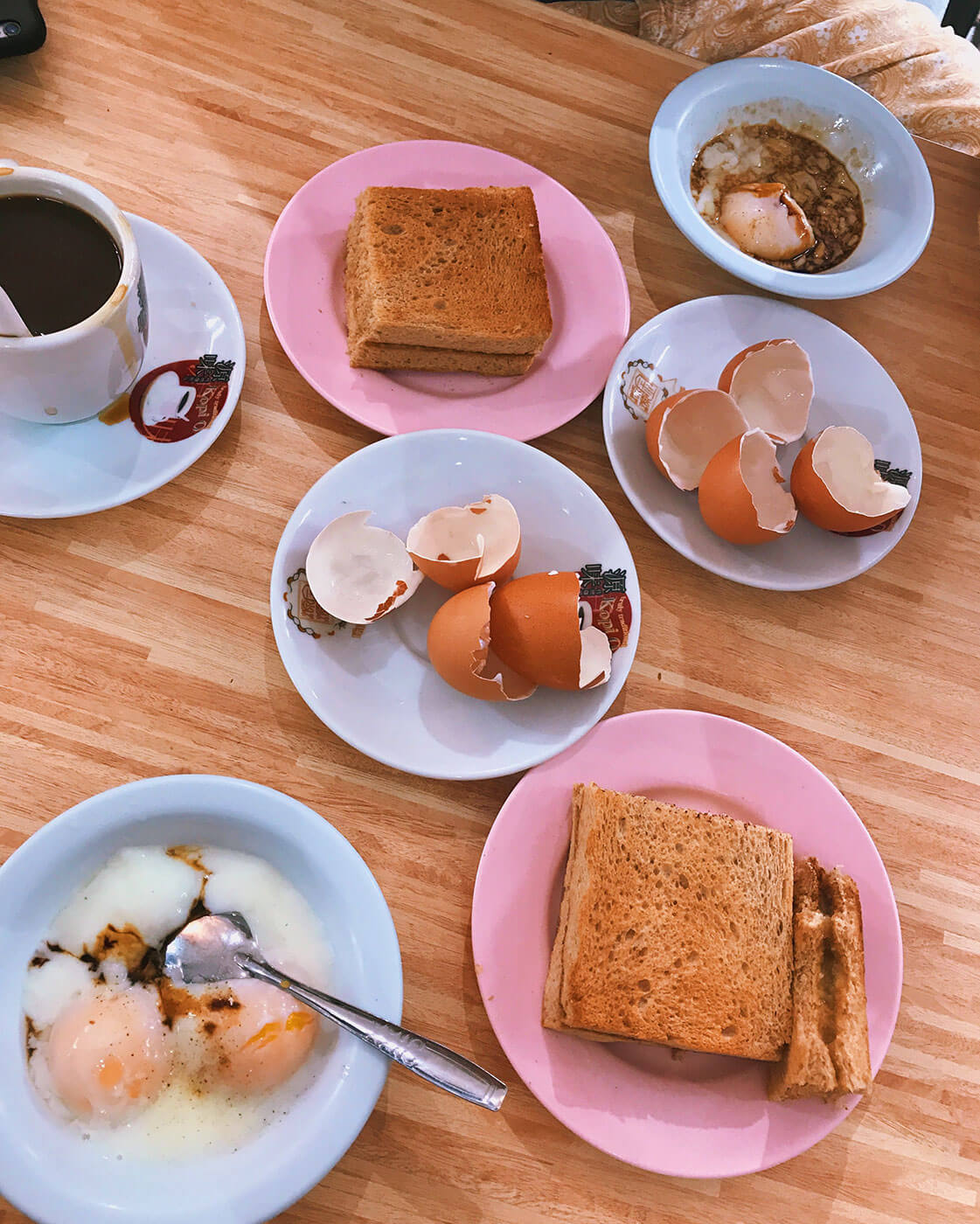
You could skip the eggs and coffee, but I highly encourage you to try at least the Kaya toast, served with kaya jam and butter. Kaya jam is made from coconut milk, eggs, and sugar – and it’s delicious.
Where to Have Traditional Breakfast in Singapore
- Hap Seng Leong near Lavender MRT – Many people like going to Hap Seng Leong for its traditional vibe. While I applaud Hap Seng Leong for keeping the tradition alive, if you spot a queue here, I would advise you to go to the hawker around the corner instead. The queue moves very slowly and you can get just as good of a breakfast from other places.
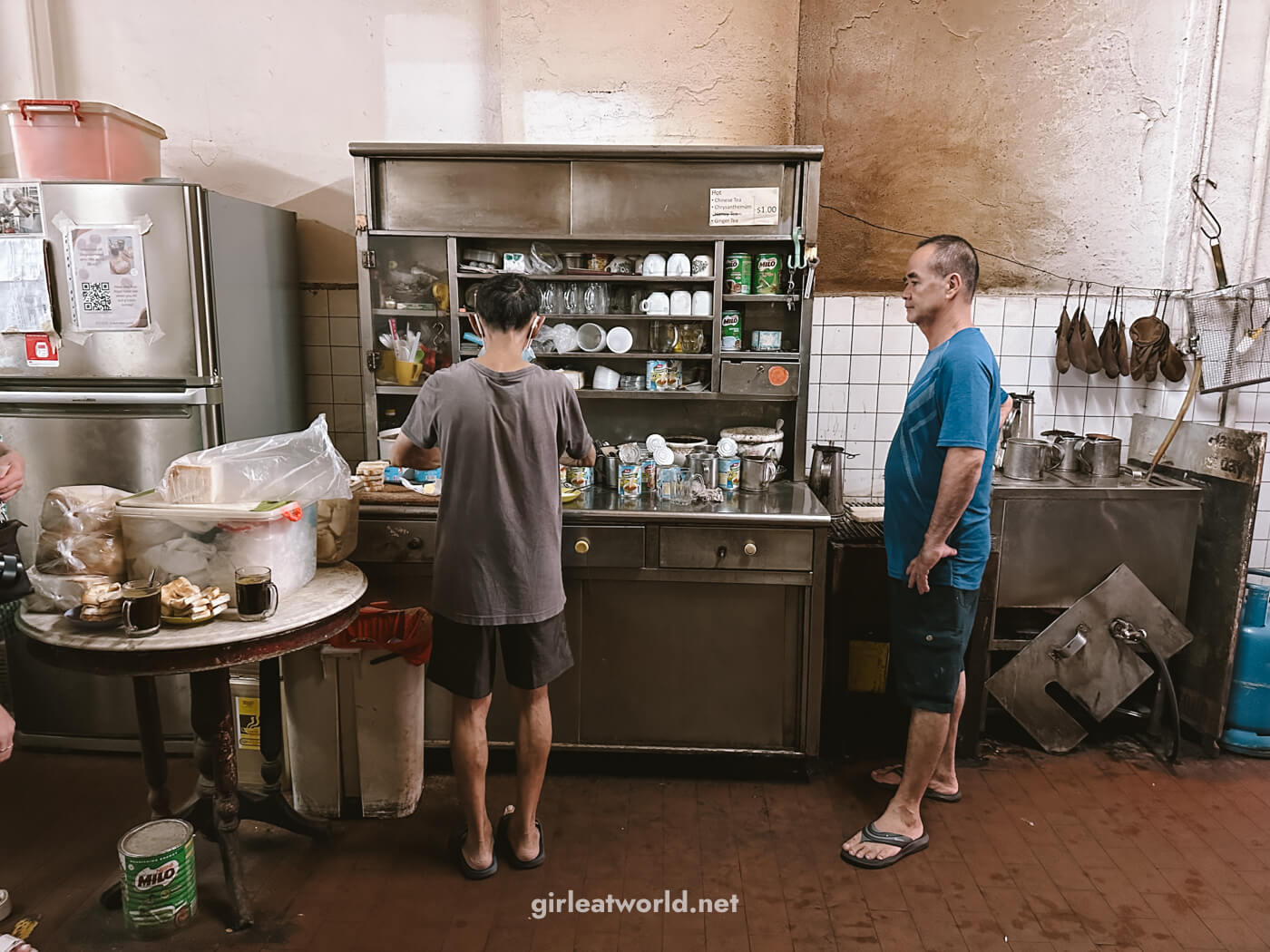
- Ah Lim Coffee House (near Lavender MRT) – Located in the hawker around the corner of Hap Seng Leong, they serve a very traditional breakfast set, and it’s delicious too!
- Ya-Kun Kaya Toast (near Chinatown or Telok Ayer MRT) – While there are multiple Ya-Kun outlets, go to their outlet on China Street – it’s their first outlet since 1944, and is their most authentic outlet!
- Toast Box (Multiple locations) – If you ask locals where they actually have breakfast, it’s probably Toast Box. There are many convenient locations across the island.
- Good Morning Nanyang Cafe (near Orchard MRT) – Located conveniently near Orchard Rd in Far East Plaza, many say they serve the best local breakfast.
- Killiney Kopitiam (near Somerset MRT) – Their original location on Killiney Road is just a stone’s throw away from Somerset Station, making it a convenient location for breakfast.
2. Hainanese Chicken Rice
Originating from Hainan in China, Hainanese Chicken Rice has been well adopted into the Singaporean culture. It is considered one of our national dishes. You’ll find a chicken rice stall in pretty much every food court and hawker centers, or restaurants that specialize in serving Chicken Rice.
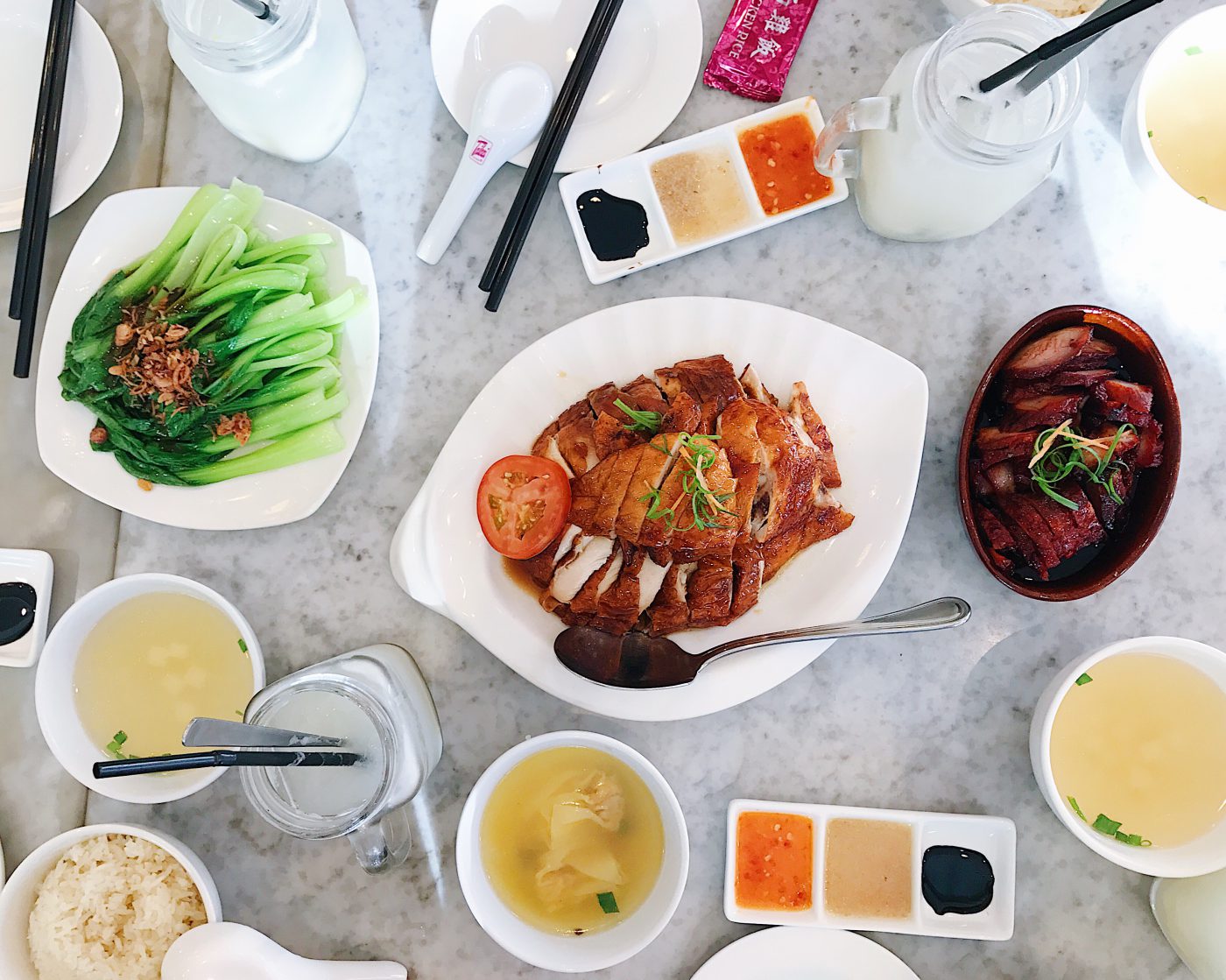
The must-order here is the chicken rice itself. The most traditional one is the steamed chicken, but you will also be able to order roasted chicken (which I prefer over steamed chicken). You can also order a few side dishes, such as fried tofu or some greens.
Despite the name, much of the importance of the dish lies in the rice itself rather than the chicken. The rice is so fragrant and full of flavors from the use of chicken broth, roasted ginger, and garlic. For me, it is truly the star of the dish!
Where to have Hainanese Chicken Rice in Singapore
- Loy Kee Best Chicken (in Whampoa) – This is my personal go-to chicken rice restaurant. Loy Kee doesn’t often appear on the list as the best chicken rice in Singapore, but don’t be fooled – the name don’t lie. Their chicken rice AND the presentation of their dishes are solid! I love the aesthetic of the personal set.
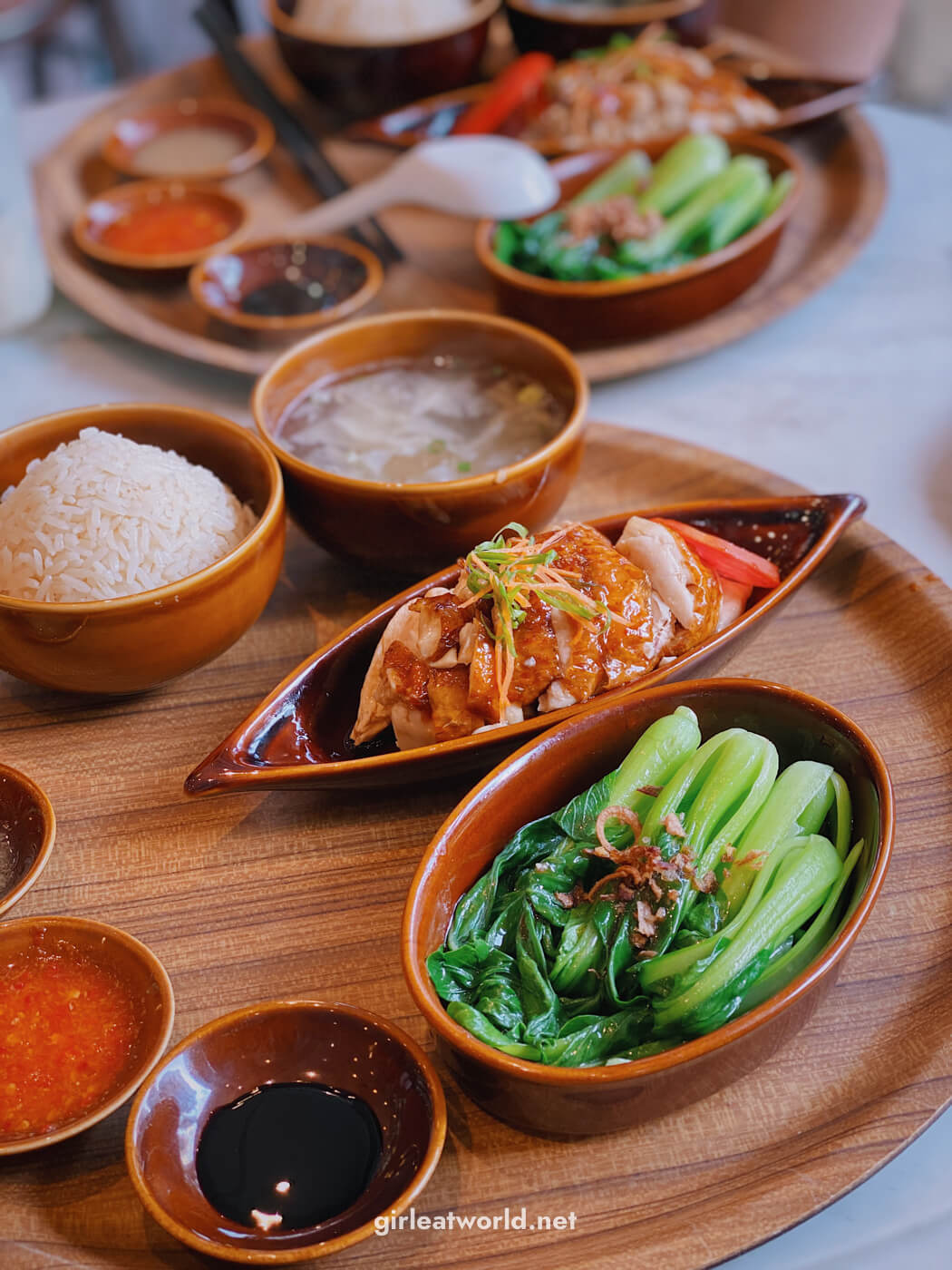
- Tian Tian Chicken Rice (near Maxwell MRT) – A very popular chicken rice stall located in Maxwell Food Center, they are known for their al dente rice. You’ll want to go early, because not only there will be queues, but they also often run out of chicken rice!
- Chatterbox (near Orchard / Somerset MRT) – Known to serve great chicken rice, but in an upscale ambiance at Hilton Orchard. While chicken rice normally only costs under $5 in hawker centers, a single portion of chicken rice will set you back $25 here. However, I think what makes Chatterbox famous is the location, and the fact that it’s presentable enough that you can take business meals here. Chatterbox only serves steamed chicken, no roasted option.

3. Yong Tau Foo
If you are a tofu lover like me, you’d love Yong Tau Foo. It is a Hakka dish consisting of a clear noodle soup with freshly blanched ingredients. It is also one of the healthier options you can find at hawker centers in Singapore.
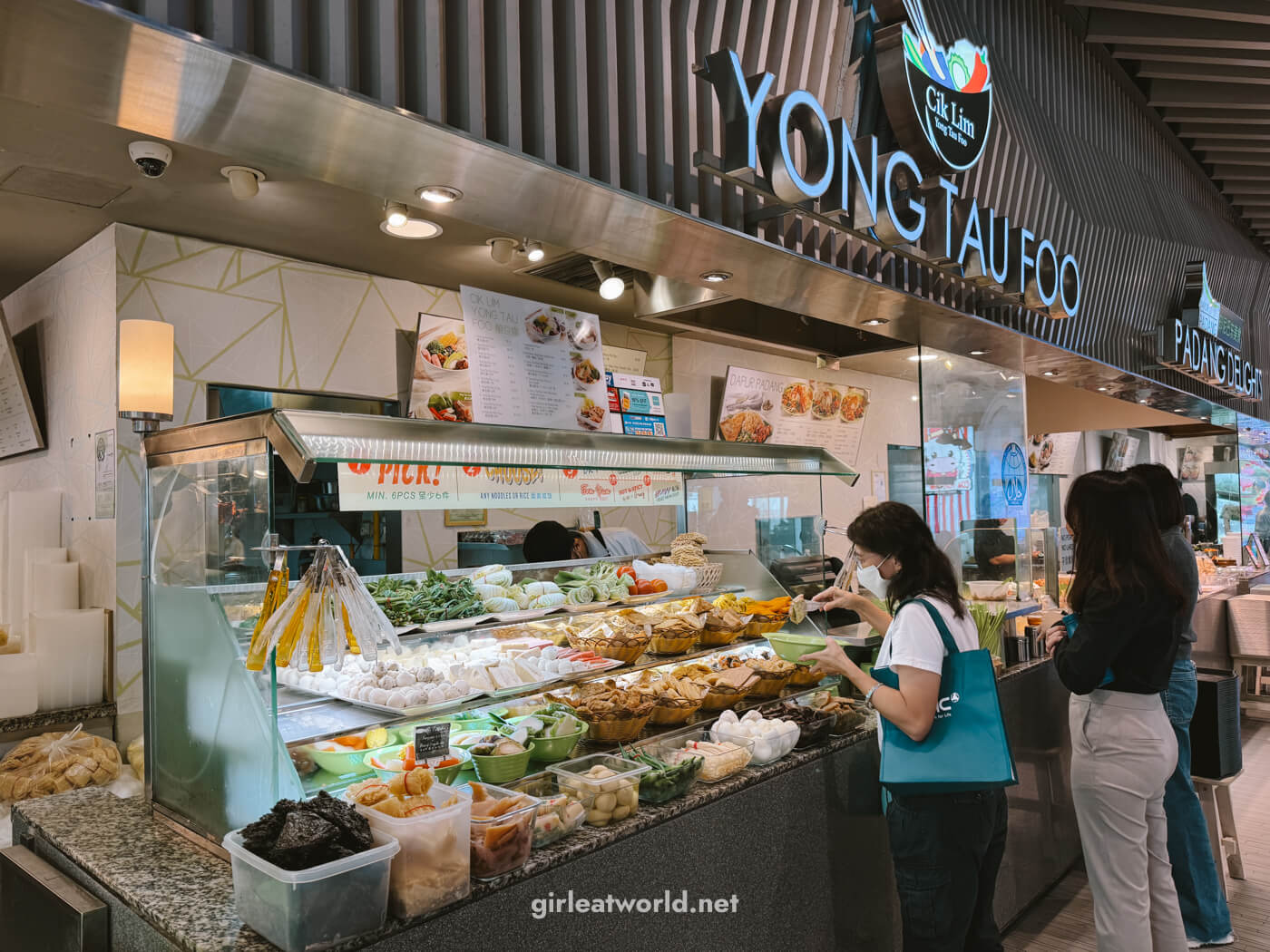
The price of a bowl depends on how many ingredients you choose and which soup you want. Usually, it’s a minimum of 6 ingredients (including a choice of carbs). Extra ingredients can still be added at an additional charge.
You start by grabbing an empty bowl and a tong at the start of the line. Then, using the tong, you choose the ingredients you want in the empty bowl. Usually, the ingredients consist of boiled tofu stuffed with fish paste, fried tofu, fresh vegetables (which they will blanch in the soup), and all sorts of meatballs. The fried ingredients might get refried, but the boiled ingredients will simply get blanched for 3-5 minutes.
Once you have what you want, you hand over your bowl to the cashier and tell them which carbs you want. Usually, the choice of carbs is thin bee hoon (rice noodles), thick bee hoon, kway teow (flat rice noodles), egg noodles, or white rice. I am a fan of the thin bee hoon! If you don’t want carbs though, you can also just skip it altogether. But you still need to meet the minimum six ingredients requirement.
You can also have a choice of the soup. Usually, the choices are regular broth (the healthiest option), laksa broth (spicy coconut milk broth), or tom yam broth (thai-inspired sour and spicy broth).
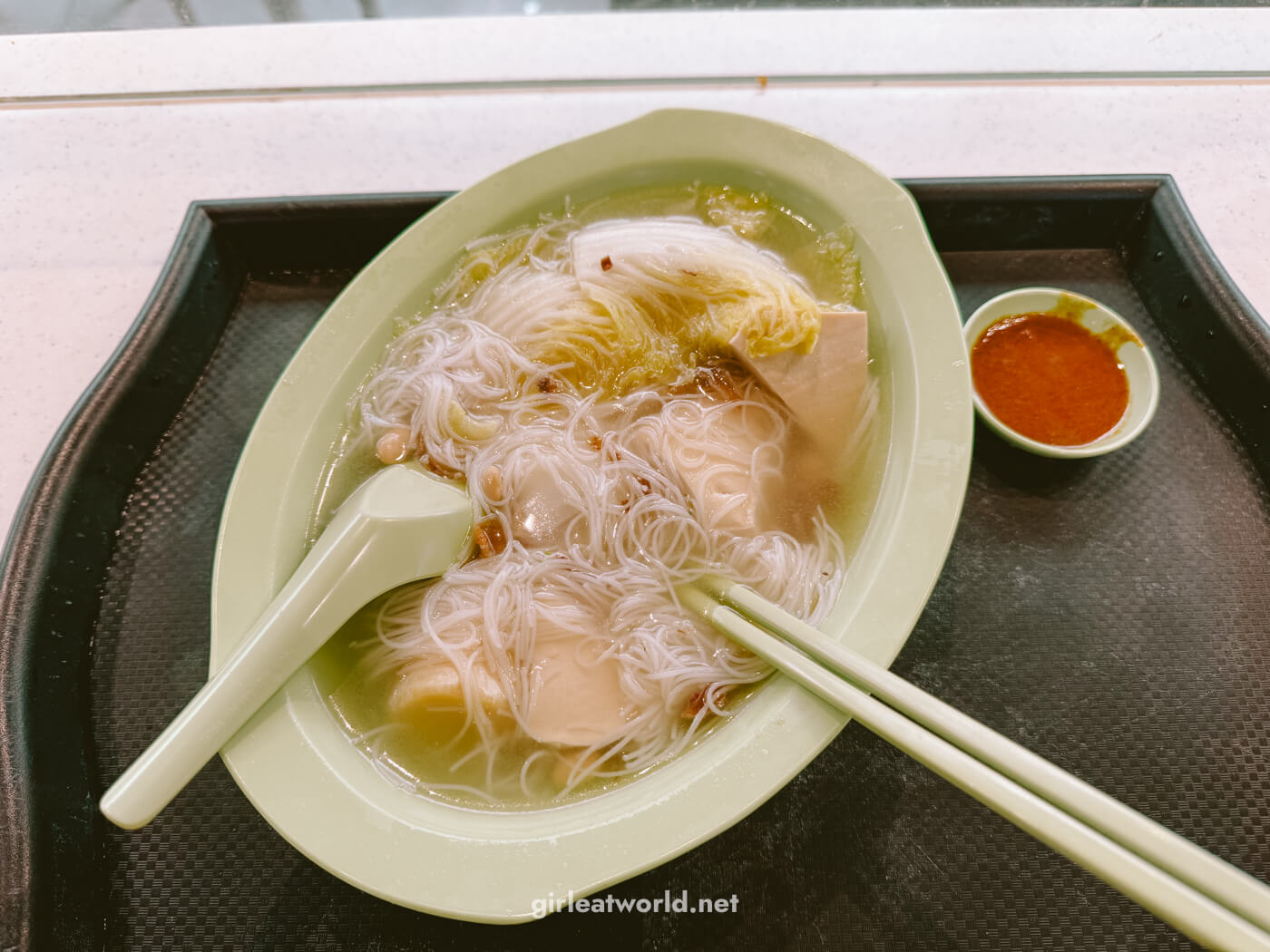
Your bowl will then be blanched for 3-5 minutes while you make payments. Once you’ve received your bowl, you can add the toppings you want: soybeans, fried shallots, and green onion. You can also get the sweet sauce and/or the spicy sauce to dip the ingredients into.
Now, remember how I said Yong Tau Foo is one of the healthier option when it comes to hawker food? Well, this is not always the case, because there is another option, which is to have it “dry” without any soup. Instead of blanching the ingredients in soup, they’ll deep fry them and serve with a meat gravy. Not so healthy, but definitely delicious.

Where to have Yong Tau Foo in Singapore
- Fu Lin Yong Tau Foo (near Telok Ayer MRT) – They have the amazing non-healthy option of Yong Tau Foo. Come early for lunch, because by noon you won’t find a seat anymore.
- 109 Yong Tau Foo (near Clarke Quay MRT)
- Jason Nian Dou Fu (Halal-certified option)
4. Bak Kut Teh (Pork Ribs Soup)
Bak Kut Teh translates to “pork ribs soup”, and that’s exactly what you’ll get. There are several types of Bak Kut Teh, but the most common one in Singapore is the Teochew kind with light, garlicky, and peppery broth.

I would also suggest you order this soup with the side dishes: rice, you tiao (Chinese fried dough), braised peanuts, braised beancurd skin and pickled vegetables.
Take note: The broth, which is arguably the best part of the dish, is refillable! You can refill them as many times as you want. Usually, there will be a server coming around with a pot of hot broth ready to fill up your bowl. If you don’t see them – don’t be shy to ask for more! It’s definitely a thing.
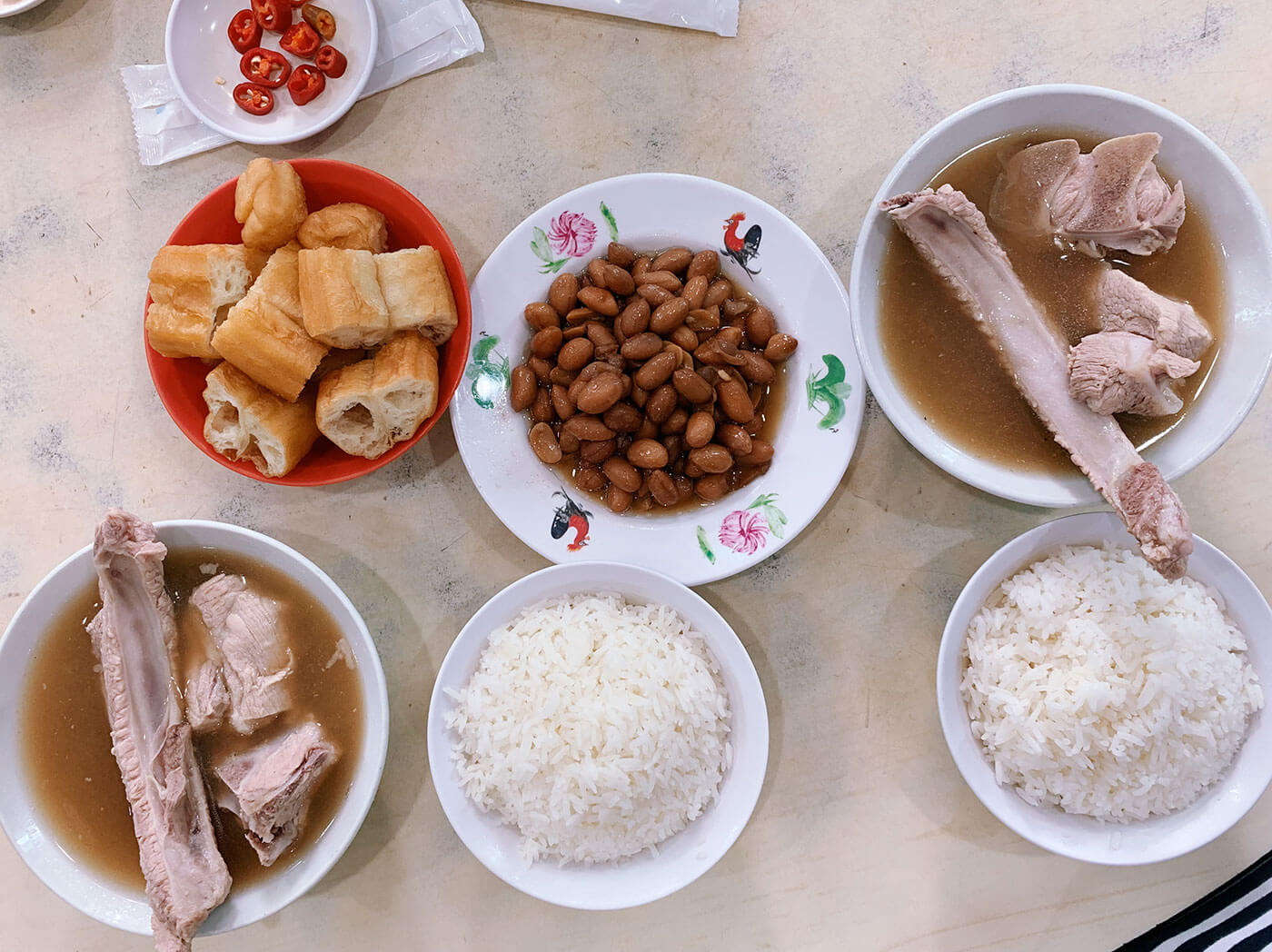
Where to have Bak Kut Teh in Singapore
- Ng Ah Sio Bak Kut Teh (near Farrer Park MRT) – This is my personal favorite. I go here at least once a month with my family. What makes Ng Ah Sio stand out is their broth – it’s extra peppery!
- Song Fa Bak Kut Teh (near Clarke Quay MRT) – Song Fa is the most accessible to tourists as its locations are quite central, but they’re also delicious!
- Ya Hua Bak Kut Teh (on Havelock Road) – A late night supper favorite, especially after going out at Clarke Quay nearby!
- Founder’s Bak Kut Teh (in Whampoa)
5. Ice Cream Sandwich
Yes, a literal ice cream sandwich – a block of square-shaped ice cream, wrapped in a piece of white bread. Many might find it strange to eat ice cream with white bread, but that’s how we roll in Singapore.
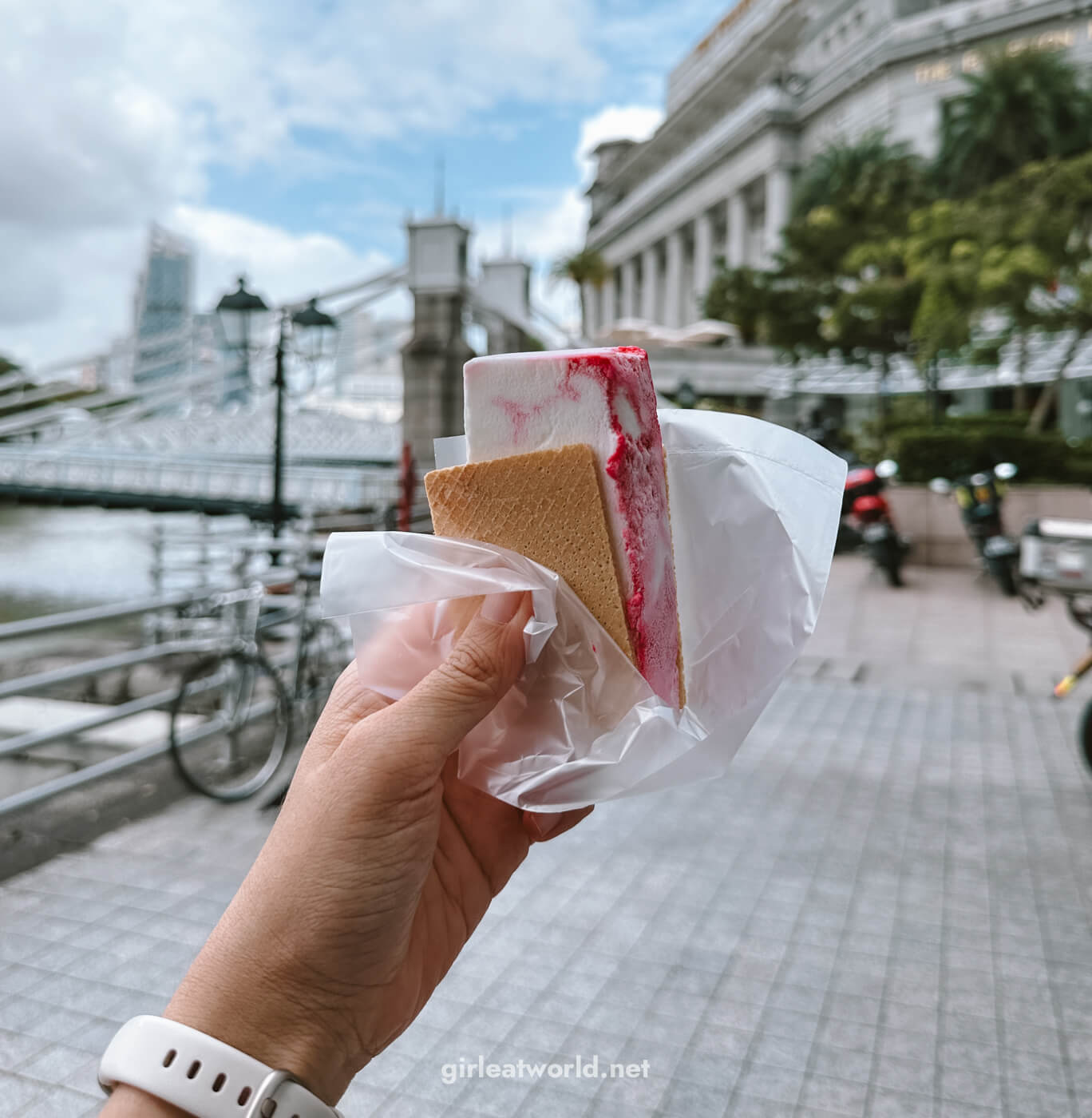
To be fair, you could choose to have wafer with the ice cream too, which I guess is what most people would be more used to. But you didn’t come to Singapore to have what you usually have back home right?
Where to have Ice Cream Sandwich in Singapore
- Any ice cream vendor! You can usually find them along Orchard Road, or the river in Boat Quay and Clarke Quay, just to name a few.
6. Chili Crab
Chili Crab is probably the one dish that Singapore can call its own. While the concept of cooking crab in spicy sauce is not new, the specific sweet and spicy sauce used for Chili Crab that it is now famous for was invented in Singapore.
Even though I am not a huge fan of crab (or crustaceans in general, because I think they look horrifying), I do love the chili crab sauce. I usually order plenty of fried mantou (Chinese wheat bread) to scoop up the sauce.
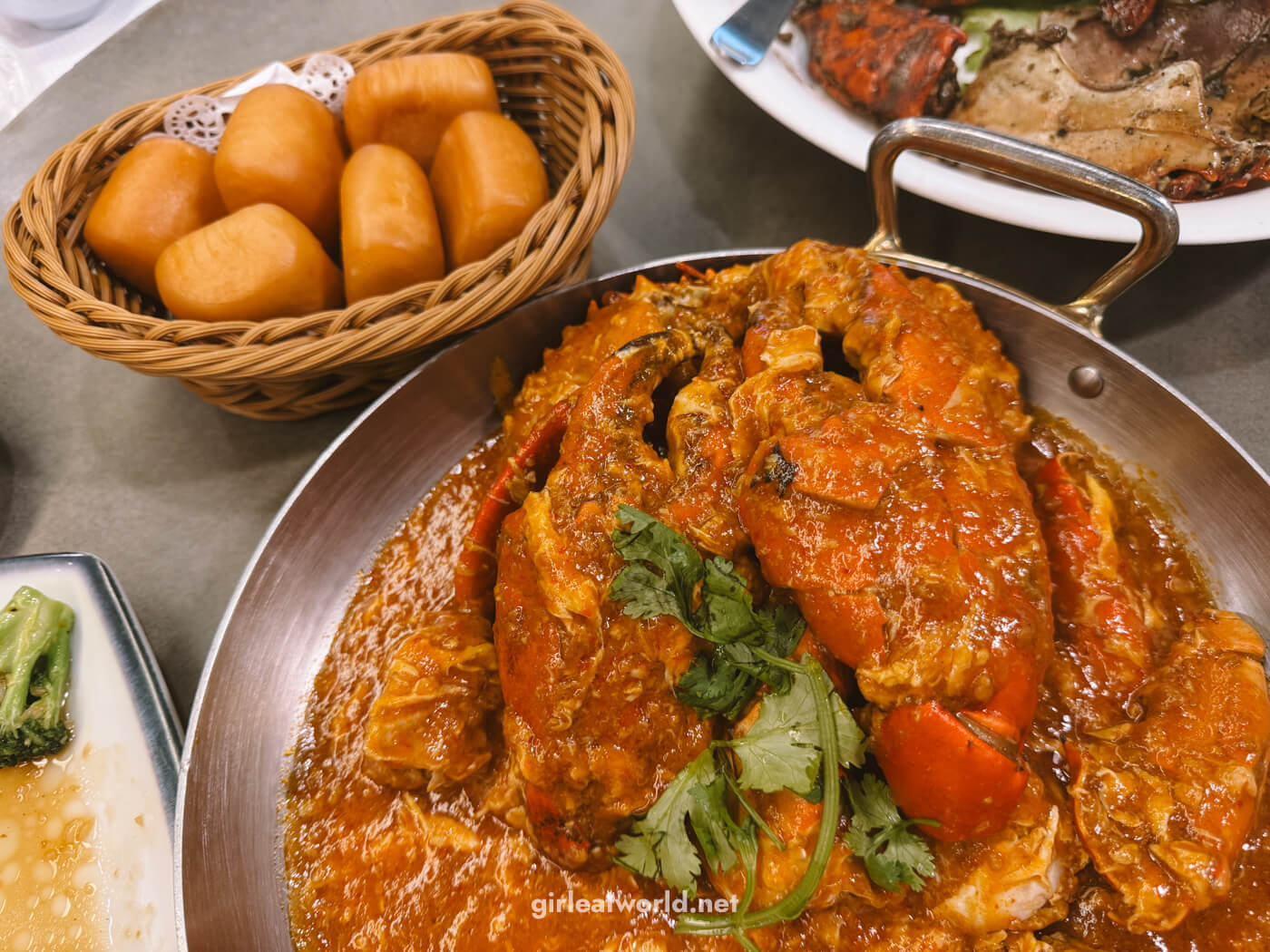
Aside from Chili Crab, restaurants often serve Black Pepper Crab and Salted Egg Yolk Crab. I love the Black Pepper too!
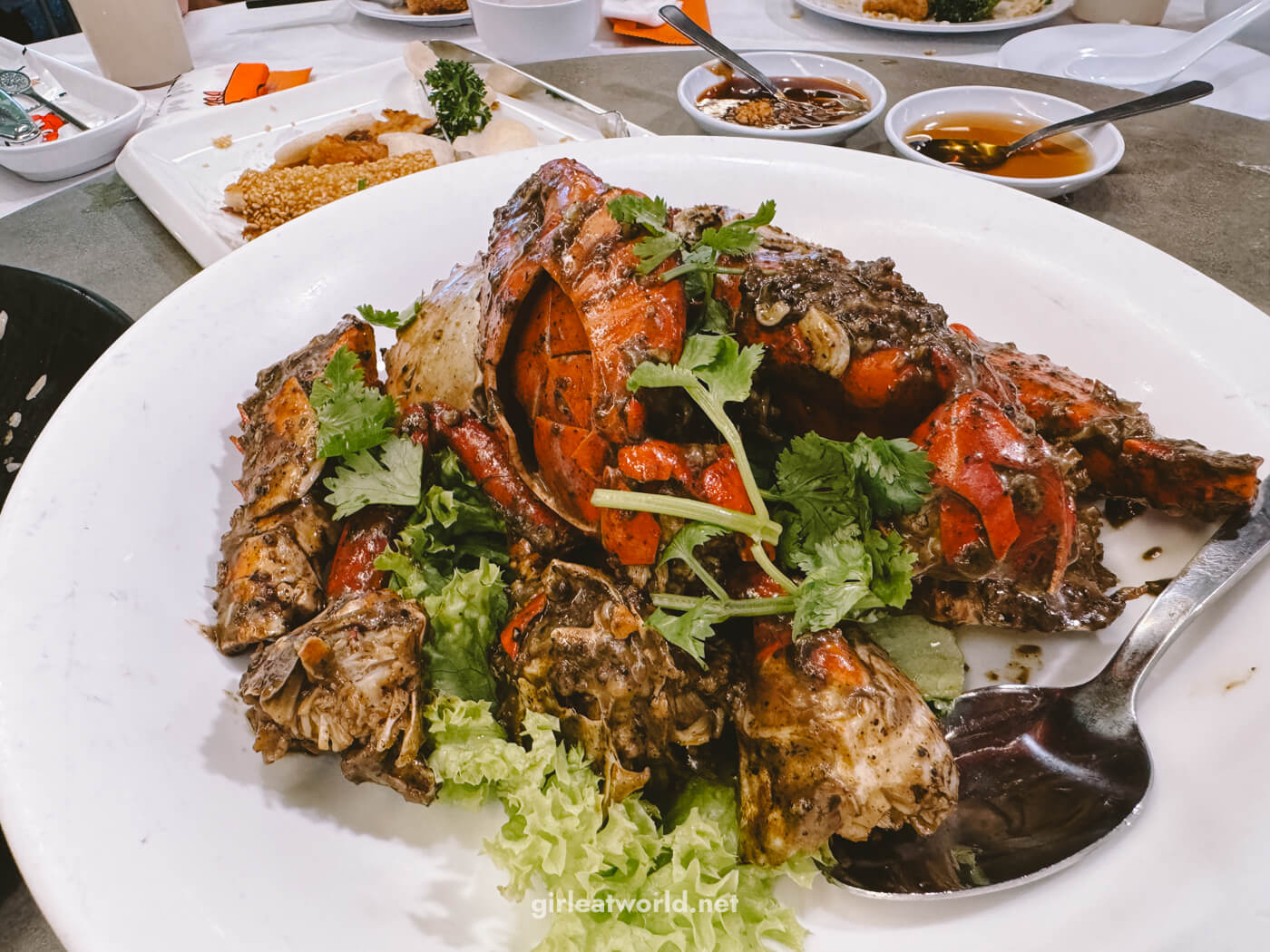
Another thing I have to note is that while other food in Singapore is relatively affordable, Chili Crab is on the more expensive spectrum. A 1.2kg mud crab could set you back $140 – 150!
Where to have Chili Crab in Singapore
- No Signboard (near Aljunied MRT)
- Mellben Seafood (near Ang Mo Kio MRT)
- JUMBO Seafood (in East Coast or Riverside)
7. Chai Tow Kway (Carrot Cake – the savory kind!)
When I first moved to Singapore, my coworkers took me to eat carrot cake. At that time, I was more familiar with the type of carrot cake that the rest of the world was accustomed to – the sweet cake made with carrots and topped with white cream cheese frosting.
But the carrot cake in Singapore is completely different. it’s a savory dish made from rice flour and white radish, which is also known as white carrot and that’s how the name carrot cake came to be. The steamed carrot cake is then fried with eggs and seafood.

There is a “black” and “white” carrot cake variety. They are not too different in terms of ingredients, except the “black” one has sweet soy sauce added to it. I prefer the white one, but you can order half and half which gives you half black and half white carrot cake, so you can try both of them!
Carrot cake can often be found at stalls that also serve oyster omelette, which brings me to my next point…
Where to have Carrot Cake in Singapore
- Grandfather Carrot Cake (in East Coast)
- Wei Wei Carrot Cake (near Tanjong Pagar MRT)
8. Orh Luak (Oyster Omelette)
I’ve visited Singapore once when I was young, about 9 or 10 years old. While I don’t remember much from the trip, I remember having my first bite of oyster omelette at a hawker center in Bedok. That combination of eggs, oysters, and the tangy chili sauce left an imprint in my memory.
Where to have Oyster Omelette in Singapore
- Famous Old Airport Road Fried Oyster (in Old Airport Road Food Center)
- 85 Bedok North Fried Oyster (in Bedok 85 Market)
- Chomp Chomp Fried Oyster (in Serangoon)
9. Char Kway Teow (Fried Rice Noodles)
Char Kway Teow is a simple fried noodle dish, consisting of Kway Teow (white flat rice noodles) stir-fried with sweet soy sauce, chives, eggs, crunchy bean sprouts, and prawns. Sometimes, there are bits of chicken as well.
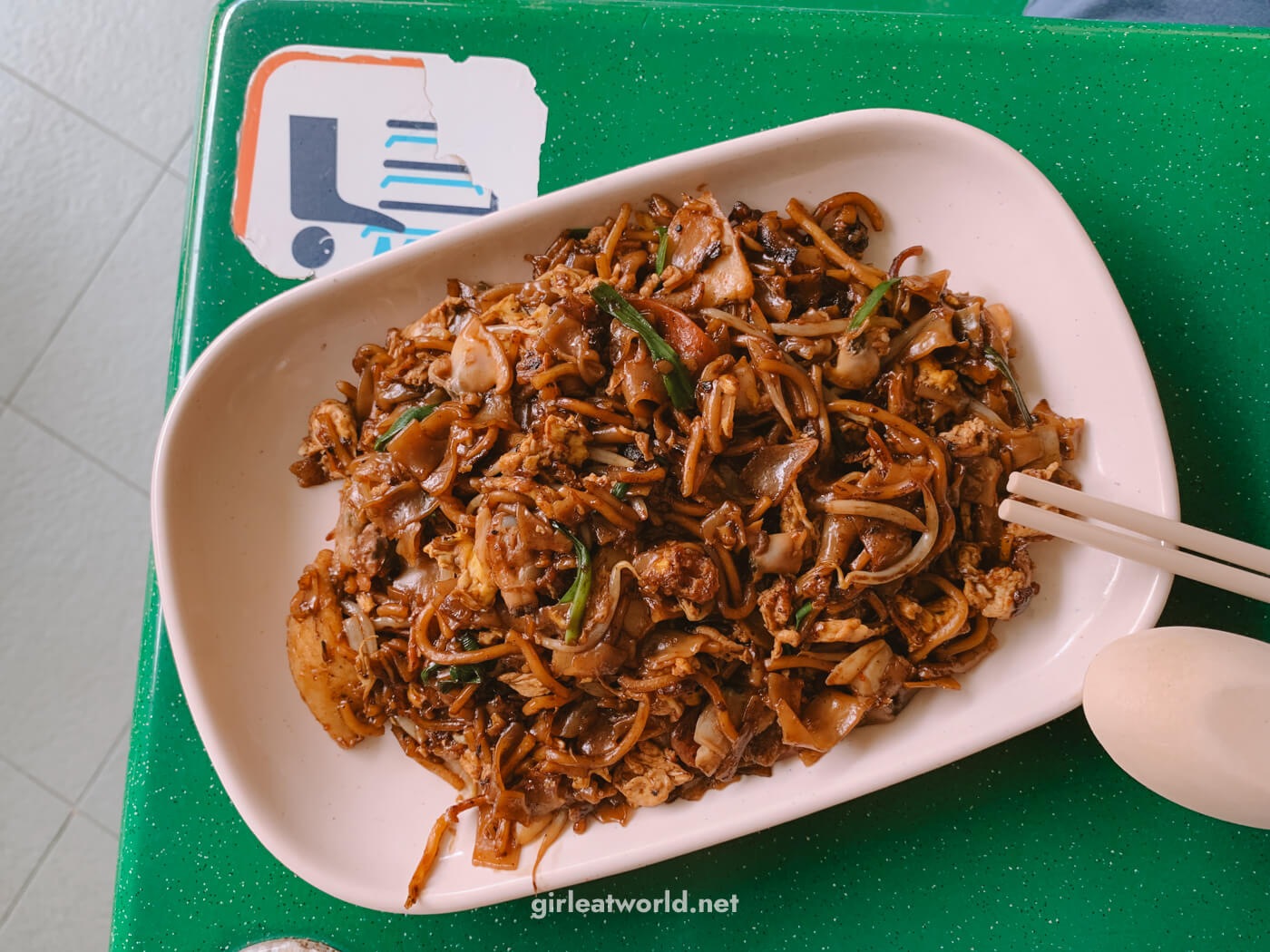
Even though I have to admit Char Kway Teow is best in Penang, it is still a well-loved meal in Singapore and we have a few contenders as well.
Where to have Char Kway Teow in Singapore
- No.18 Zion Road Fried Kway Teow (at Zion Food Court) – They received Michelin Bib Gourmand
- Lao Fu Zi Fried Kway Teow (at Old Airport Road Food Center)
- Outram Park Fried Kway Teow (near Outram Park)
10. Peranakan Cuisine
What is Peranakan? In Indonesian and Malay language, anak means children or descendants. In Singapore, it is understood that Peranakan refers to an ethnic group created from a mix of Chinese ancestry from immigrants with local Malay and Indonesian. You’ll often come across the term Baba-Nyonya in Peranakan culture. Baba is used for males while Nyonya refers to females.
Some of the most famous Peranakan dishes you can find in Singapore are Popiah, Kueh Pai Tee, Rendang, and Ayam Buah Keluak.
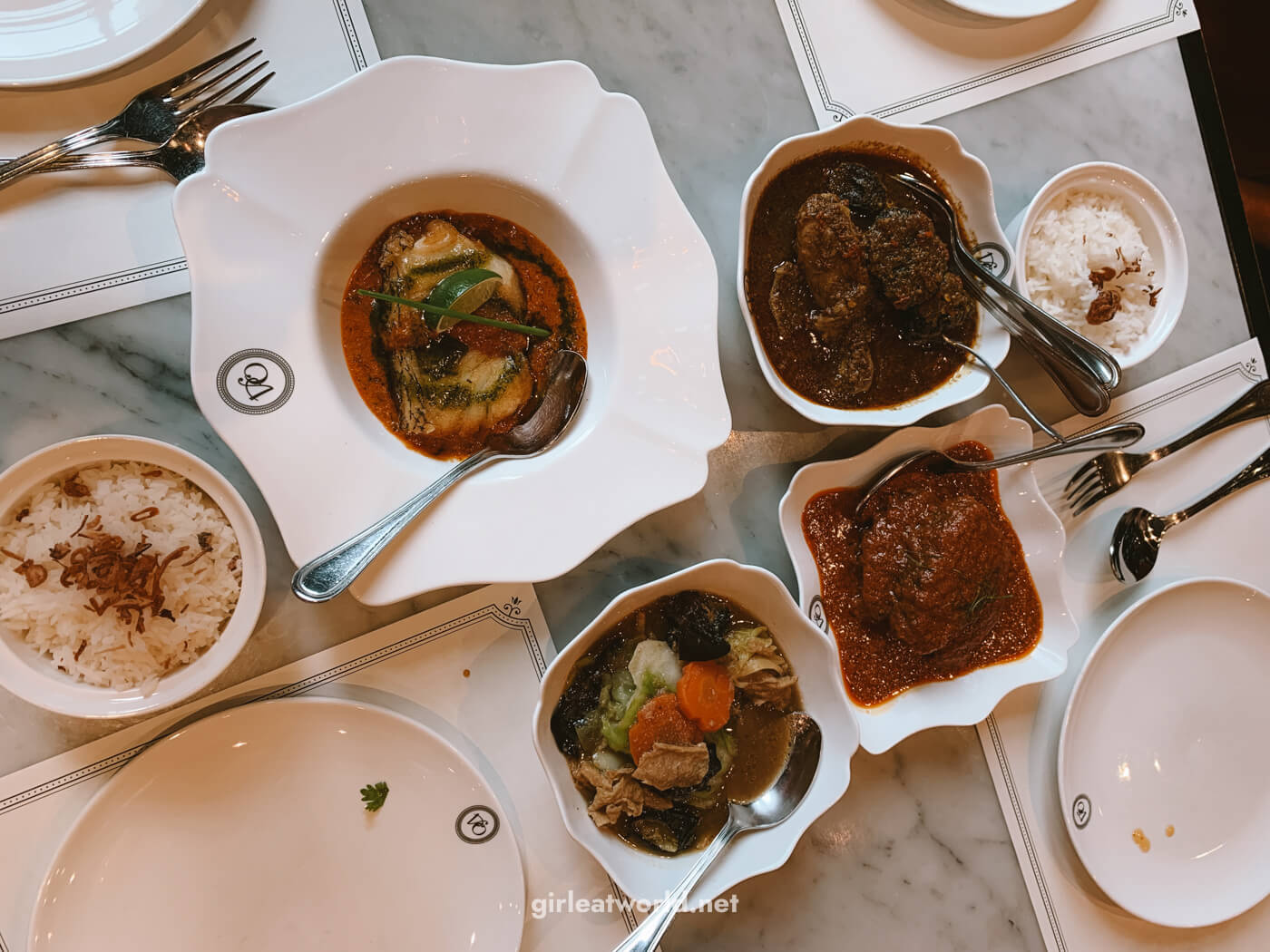
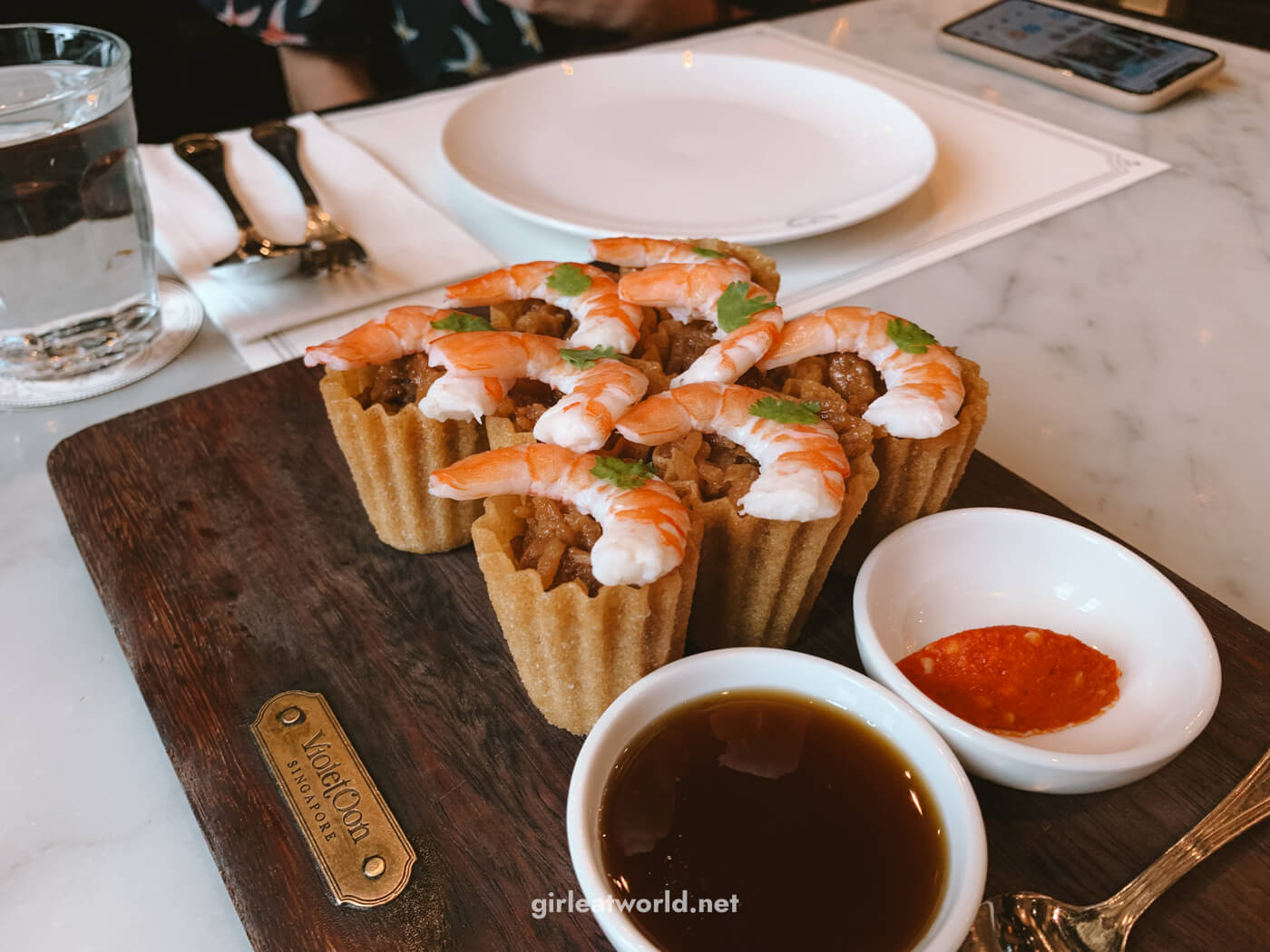
I love Popiah the most, especially when it’s served DIY-style at someone’s home where you can roll your own Popiah. That way, I can customize it to my liking – I can put as many or as few ingredients as I want. In Singapore, you can try Po Restaurant for a DIY popiah experience.
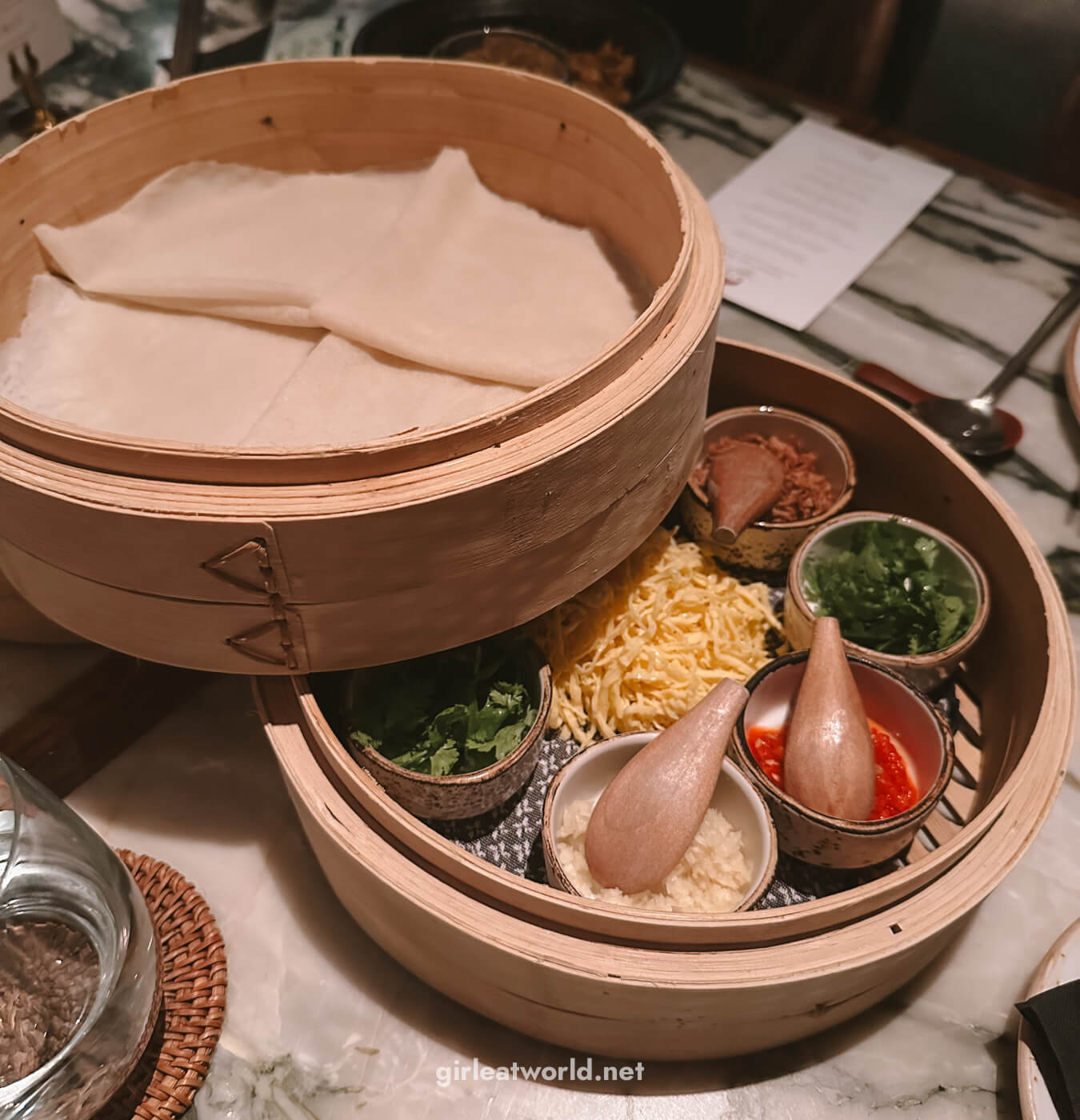
Another interesting one is Ayam Buah Keluak, which is chicken gravy with Buah Keluak (Pangium seed). Buah Keluak contains cyanide, but when processed correctly it became a delicious addition to the dish.
Where to have Peranakan Cuisine in Singapore
- National Kitchen by Violet Oon – There are a few Violet Oon restaurants in Singapore, but the one with the vibe that guarantees to “wow” is the National Kitchen in the National Gallery Museum.
- Po Restaurant – A modern restaurant serving singapore and chinese classics. They serve popiah in a DIY manner – so you can put as little or as many ingredients as you want!
- Candlenut – Michelin-starred Peranakan restaurant
- The Blue Ginger – Situated in a shop house with peranakan decoration. Not only the food is good, it has great vibe too!
- Rempapa at National Gallery
11. Laksa
Laksa is a spicy noodle with broth made from rich coconut milk and seafood, served with thick rice noodles and topped with prawns, fish cake, and beancurd skin.
I’m not gonna lie – I am NOT a huge fan of prawn or shrimp (I think they have way too many legs), but I have to admit that Laksa is really good. I can see why Laksa gained its reputation as a comforting noodle dish and can be commonly found in Singapore.
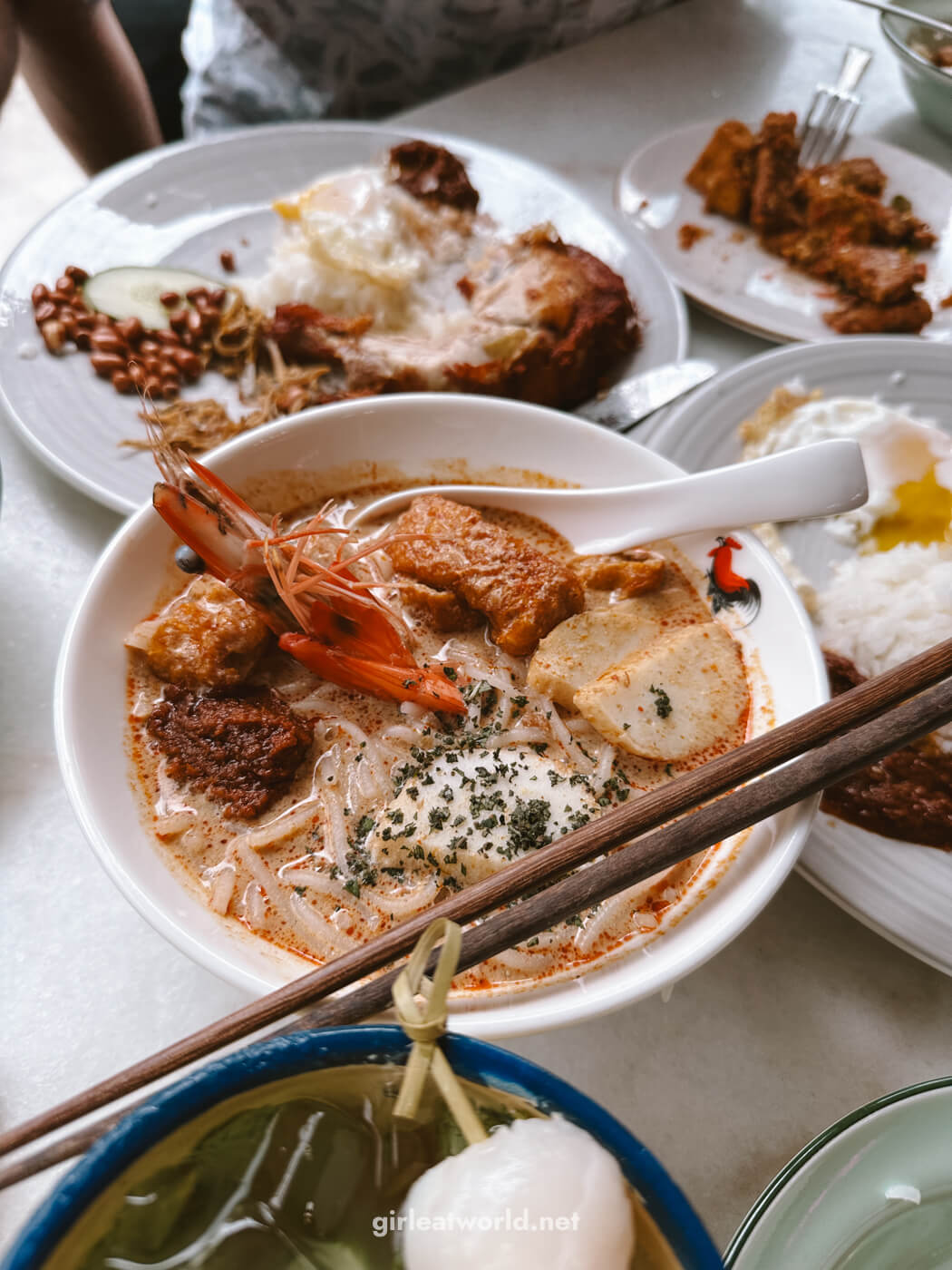
My favorite place to have Laksa is Wild Coco. They have an eggy laksa option, which omits the prawn and replaces it with sunny side up. Perfect for a crustacean-haters like myself 😛
Where to have Laksa in Singapore
- Laksa Labo at Wild Coco (near Lavender MRT, and a few other locations)
- Min Ji Laksa (near Boon Keng MRT)
- 328 Katong Laksa (in Katong)
12. Nasi Lemak
Nasi Lemak means “Fatty Rice” in Malay. Why “fat”? The rice is cooked in rich coconut milk and pandan leaves, giving it that rich nutty flavor. It is usually served with fried Ikan Bilis (Anchovies), boiled eggs, slices of fresh cucumber, fried peanuts, and fried chicken. And don’t forget to add a dollop of Sambal chili if you can take it 😉
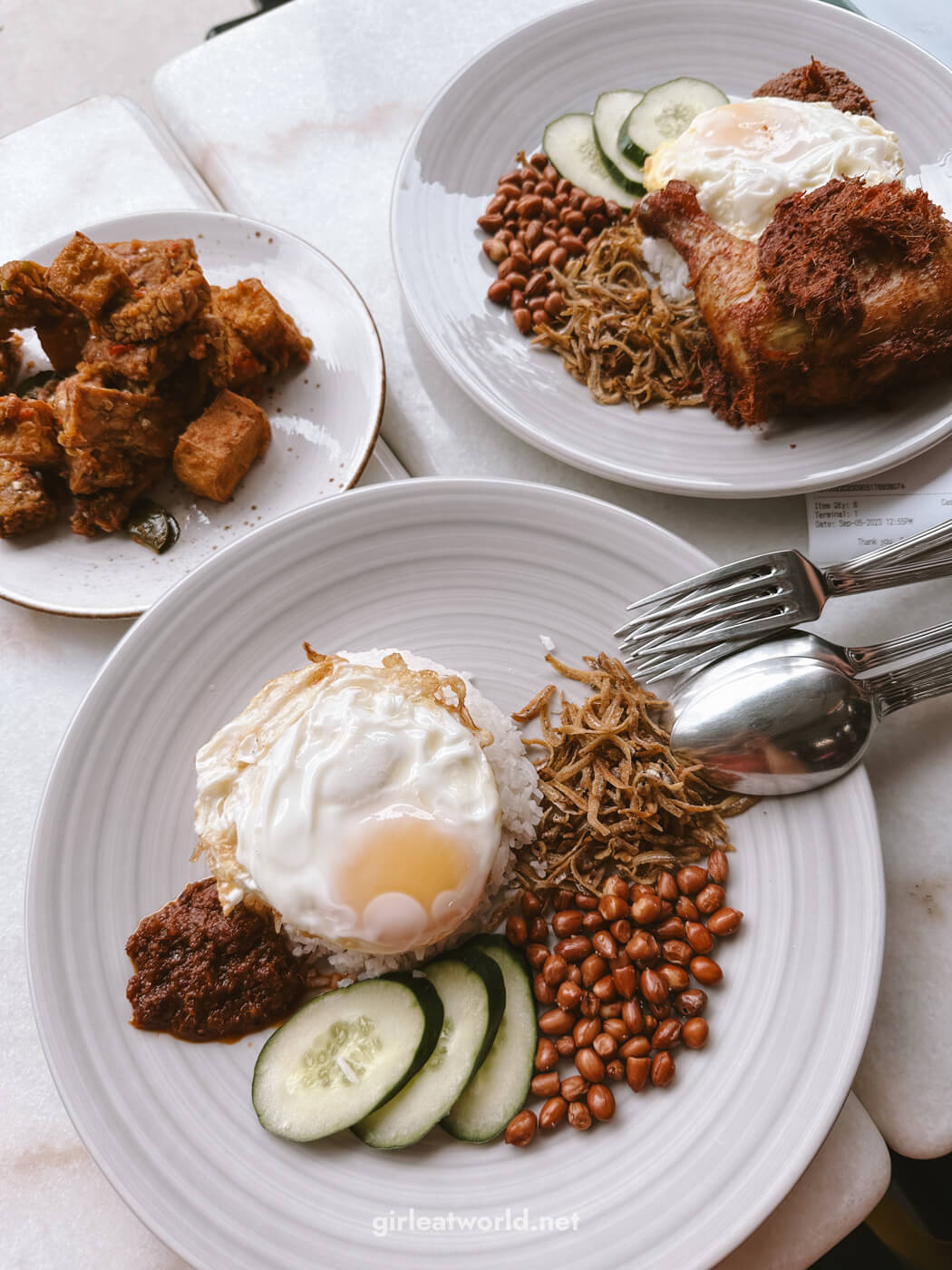
In Singapore, Nasi Lemak has had a sort of revival. Traditionally found in hawker centers as a cheap quick meal, there have been a few restaurants popping up that specialize in premium Nasi Lemak, starting from The Coconut Club. These new restaurants would use the best ingredients, larger chunks of chicken or fish, and plate the Nasi Lemak aesthetically. I’m all for it!
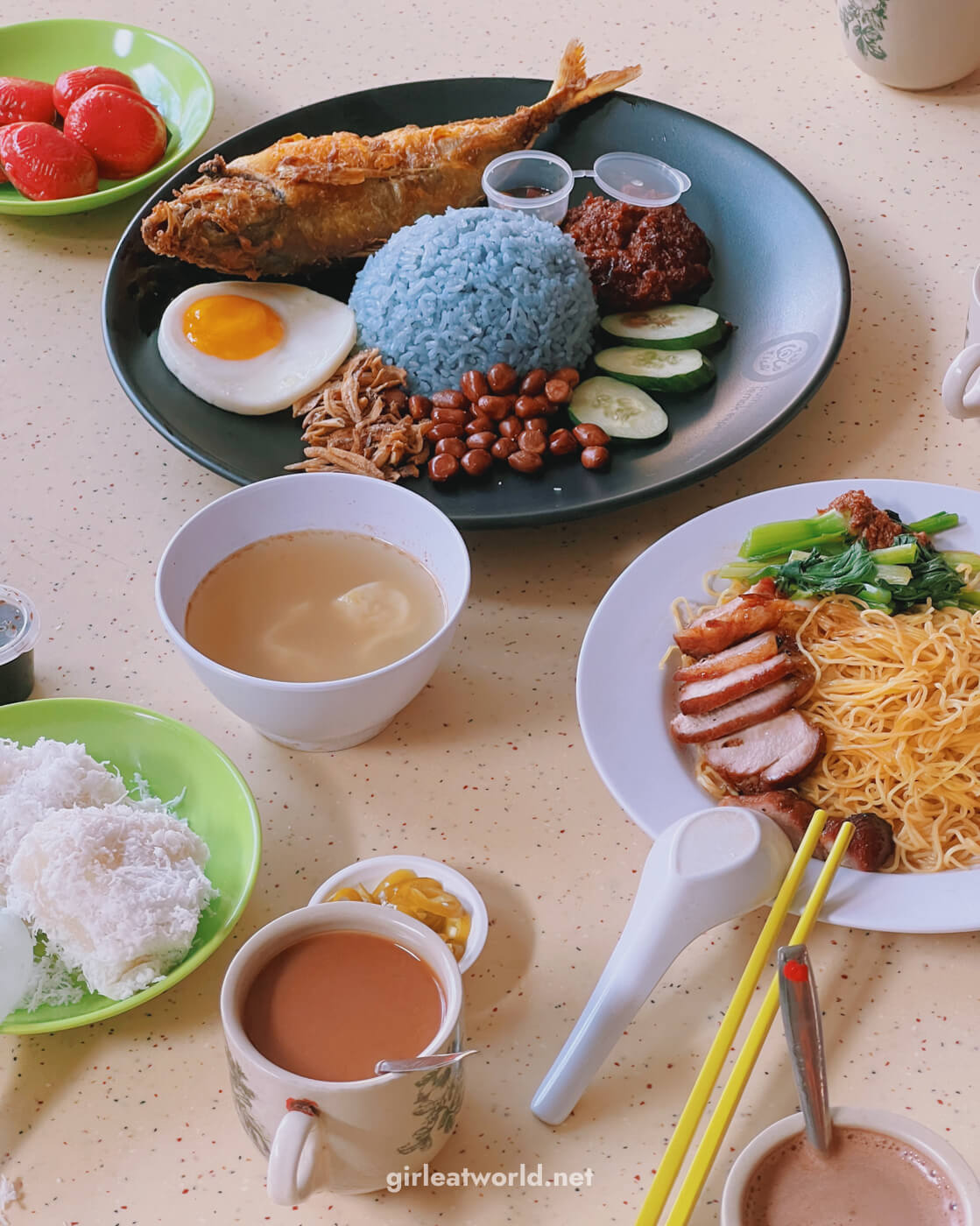
Where to have Nasi Lemak in Singapore
- Market Street Nasi Lemak (near Raffles Place MRT) – Located at a hawker near the business district, so avoid coming here during lunchtime on weekdays.
- Wild Coco (near Lavender MRT) – My current favorite Nasi Lemak, and they have great Laksa too!
- The Coconut Club (near Bugis MRT) – The restaurant that kickstarted the new Nasi Lemak movement in Singapore. They have received Michelin Bib Gourmand.
- Dickson Nasi Lemak (in Joo Chiat) – Takeaway only
13. Nasi Biryani
Biryani was brought over to Singapore by the Indian Muslim community and adapted to local taste. The fragrant basmati rice is flavored with saffron and various other spices. While the Biryani in India often cooks the meat together with rice, in Singapore, the meat is cooked separately. It is often served with chicken curry or mutton curry, and a side of acar (pickled vegetables).
It’s not a dish to eat when you’re trying to be healthy, but I can tell you that it’s well worth the calories.

Where to try Nasi Biryani in Singapore
- Bismillah Biryani Restaurant (near Rochor MRT)
- Mr Biryani (in Little India)
- Golden Nur Nasi Briyani (at Market Street Hawker Center)
- Zam Zam Restaurant (near Bugis MRT)
- Casuarina Curry Restaurant (in Thomson)
14. Hakka Lei Cha Fan (Thunder Tea Rice)
Yet another Hakka dish that has been adopted into the Singapore culture. I have to warn you that Thunder Tea Rice is not for everyone. The dish calls for plenty of greens and herbs, which some people are averse to. For me, I LOVE this dish!
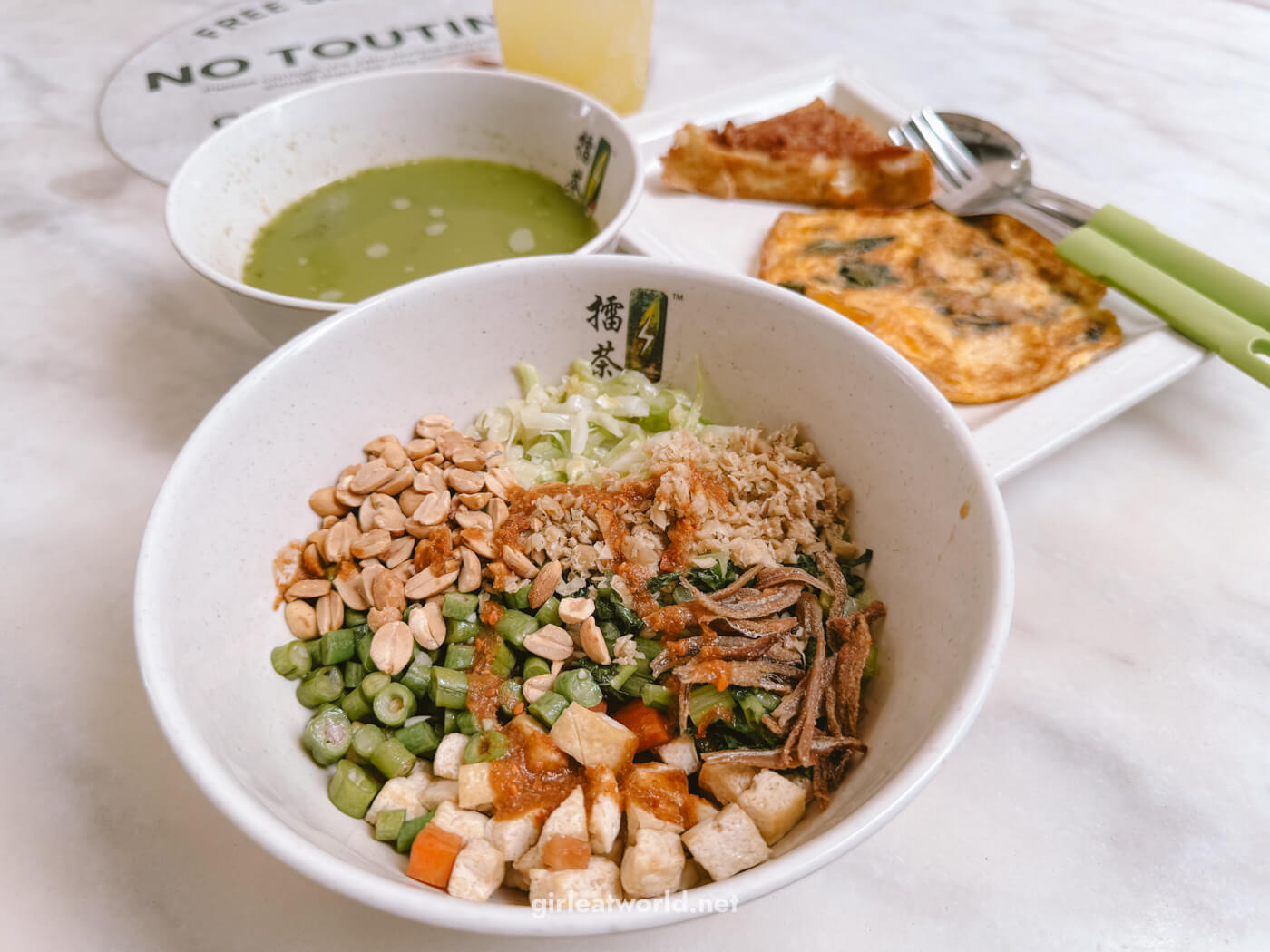
Thunder tea rice in Singapore is usually white or brown rice topped with chopped long beans, cabbage, peanut, fried tofu, dried shrimp, ikan bilis (fried dried anchovy) and served with a green herbal soup made from green tea, basil, and mint. You can mix the soup into your rice if you’d like.
This dish is also considered healthy and can lower cholesterol levels.
Where to have Thunder Tea Rice in Singapore
- Thunder Tea Rice (at Lau Pa Sat)
- Hakka Thunder Tea Rice (at Margaret Drive)
15. Ban Mian (Handmade Noodles)
When I’ve been away from Singapore for a while and I miss the food, Ban Mian is often the first thing I think of. Roughly translated as “Board Noodles” in Hokkien, Ban Mian is a very simple noodle soup dish. It consists of handmade, straight, and flat noodles which lends to its name – the noodles are cut using a board to keep it straight.
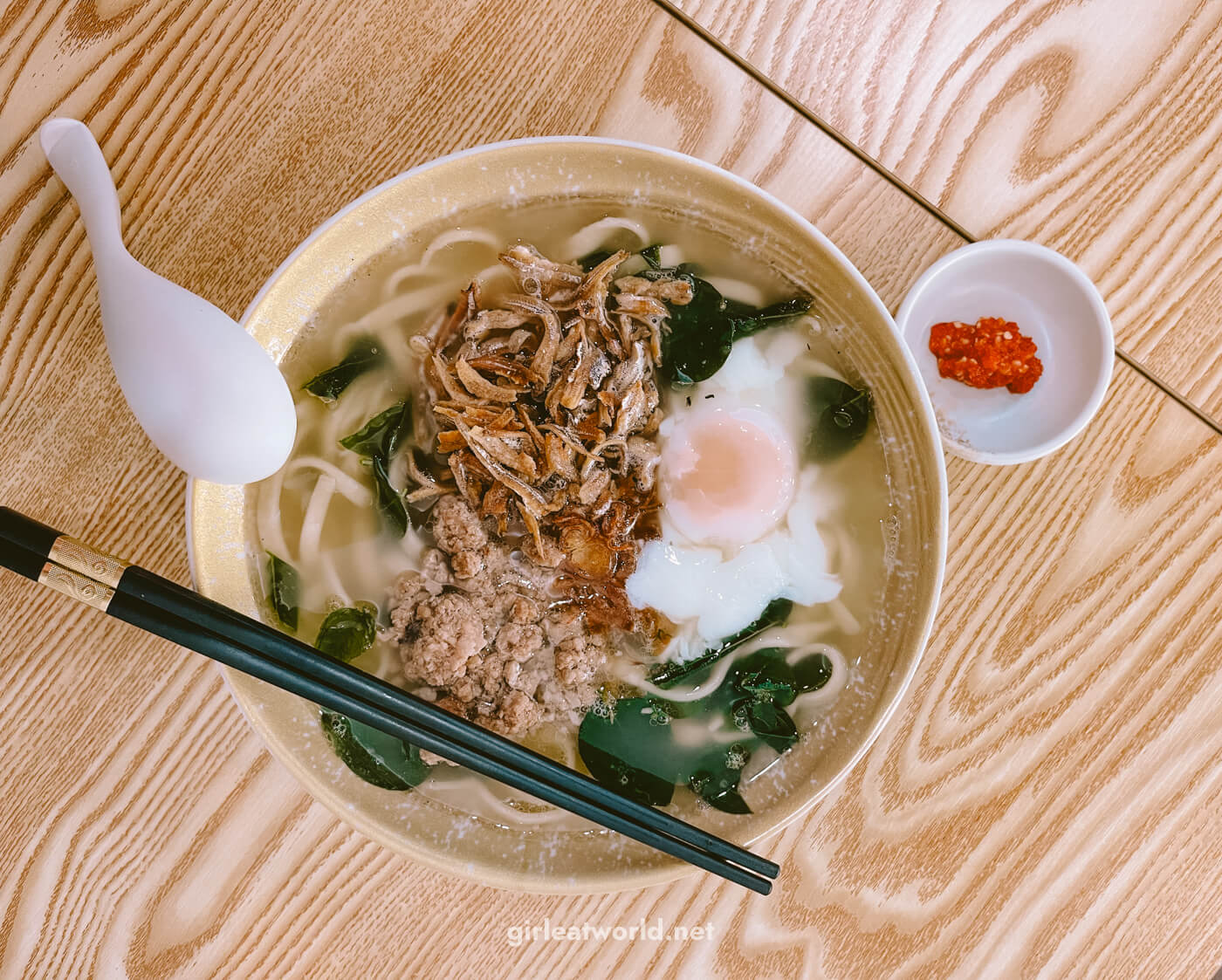
The noodle bowl is topped with fried anchovy (ikan bilis), half-poached egg, blanched spinach, braised mushroom, a bit of minced meat, and a clear broth made from pork and anchovies.
I love every part of Ban Mian, but my favorite part has got to be the noodles. They’re usually chewy and just the right slip to it, making it easy to slurp away.
Typically, at the same stores, you’d have a choice for the noodles aside from Ban Mian noodles: U-Mian (which is thinner than ban mian), Mee Sua (even thinner noodles, similar to angel hair pasta) or Mee Hoon Kueh (irregularly shaped dough that is torn into nuggets).
Where to have Ban Mian in Singapore
- Qiu Lian Ban Mian (at Lau Pa Sat, but there are also multiple branch across Singapore)
- Formosa Delight (at Food Republic)
- Prince Noodles (near Bendemeer MRT)
16. Bak Chor Mee (Minced Pork Noodles)
Bak Chor Mee, aka Minced Pork Noodle, is one of Singaporean’s most well-loved dishes. Affordable, comforting, and delicious, you’ll find Bak Chor Mee (lovingly abbreviated as BCM) in practically every hawker center around Singapore.
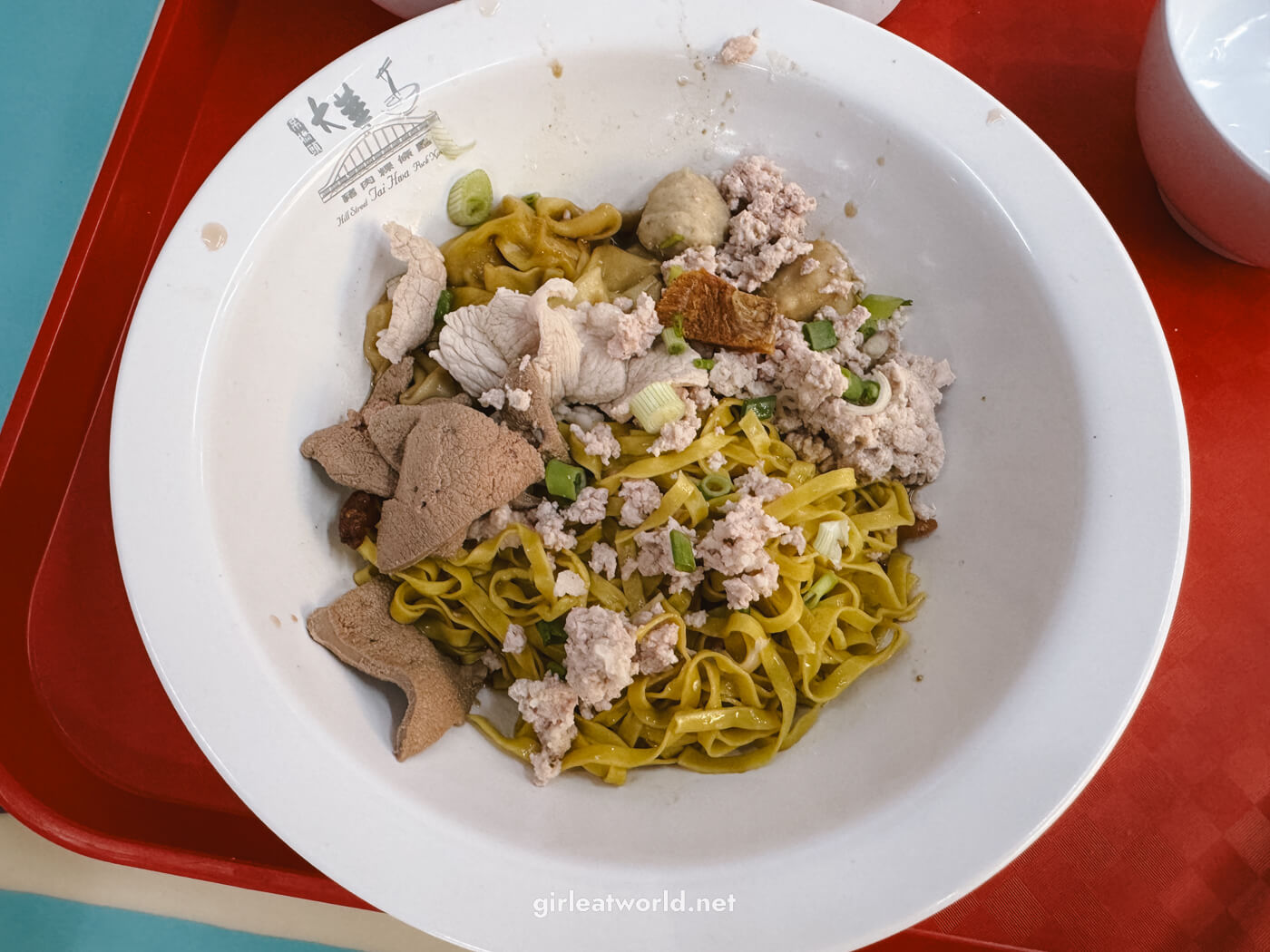
There are two variations of BCM: with soup or dry noodles. The most popular is the dry version, where the noodles are tossed in oil, chili, and vinegar, and served with toppings like minced pork, sliced pork, meatballs, pork liver, wonton, or fried salted fish. The vinegar adds a tang to the noodles, which cuts the oil well making it less heavy.
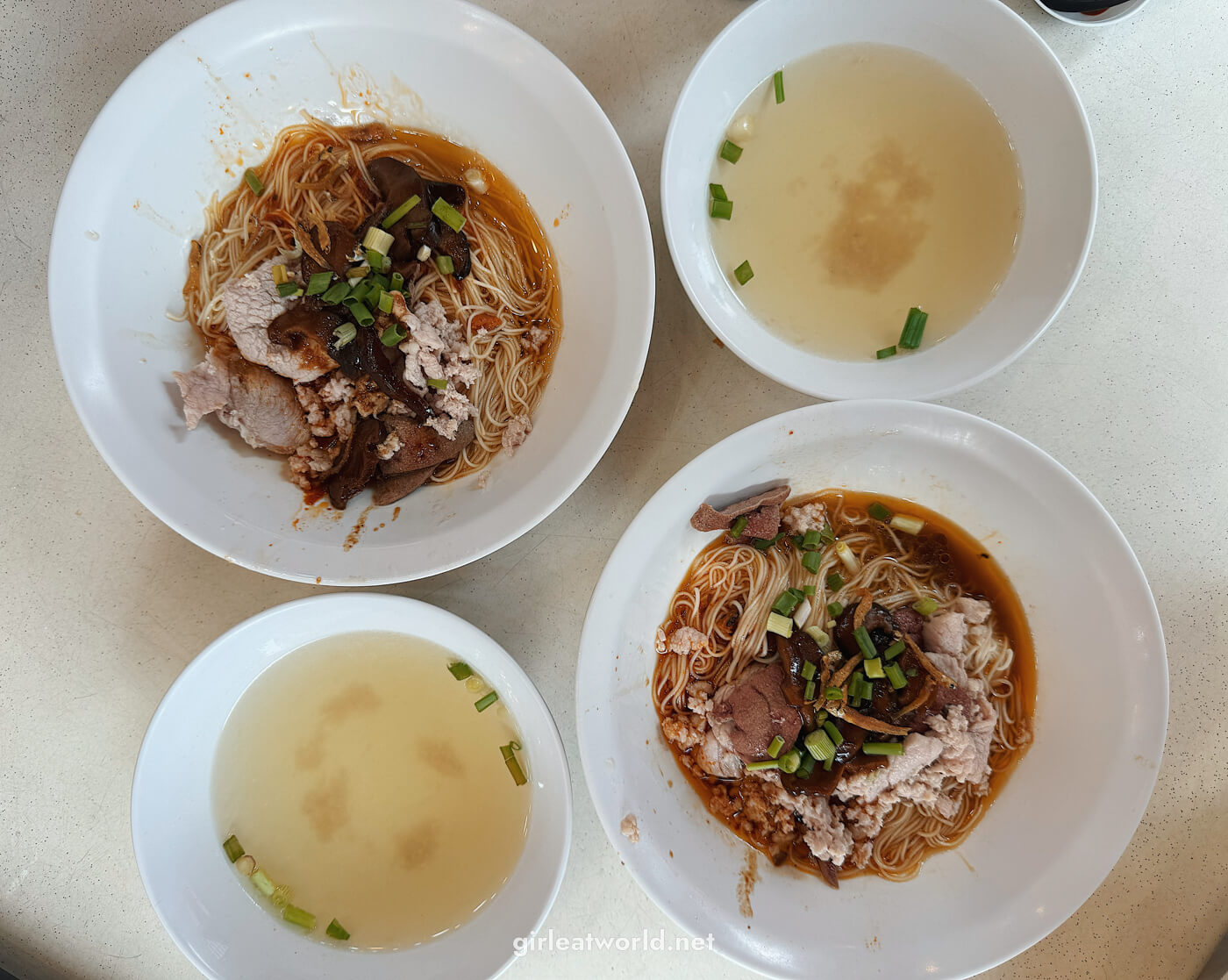
You also get to choose the noodles, and my favorite is mee sua. It’s difficult to cook mee sua correctly due to the thinness of the noodle (easy to overcook), but when it’s done correctly, it is such a delight.
Where to have Bak Chor Mee in Singapore
- Hill Street Tai Hwa Pork Noodles (near Lavender MRT) – The most popular bak chor mee in town. This stall has been awarded one Michelin star since 2016 for high-quality cooking. Read my dedicated review on this stall.
- Seng Huat Bak Chor Mee (near Bugis MRT) – The portion is on the smaller side, so if you’re particularly hungry you might want to order another bowl of noodles. I ordered an extra fishball noodle when I was there and it was delicious!
- Macpherson Minced Meat Noodle
- Soon Heng Pork Noodles
17. Wanton Mee
A Cantonese noodle that is popular in Singapore, the dish is made up of egg noodles, wontons (dumplings with shrimp filling), char siu, and green vegetables. Although there is a soup version, usually the dry version is more popular.

Where to have Wanton Mee
- One Ton Mee
- Wanton Fu Wanton Mee
- Eng’s Wantan Mee
- Ji Ji Wanton Noodle Specialist
18. Dim Sum
Dimsum consists of small dishes, so you can order many of them and taste different ones. It’s like Asian tapas! It Sum is originally a Cantonese breakfast tradition that has been well-adopted in Singapore.
Here, it’s pretty common to head to a hotel or high-end restaurant with extended family on a Sunday morning and have a large dim sum breakfast together.
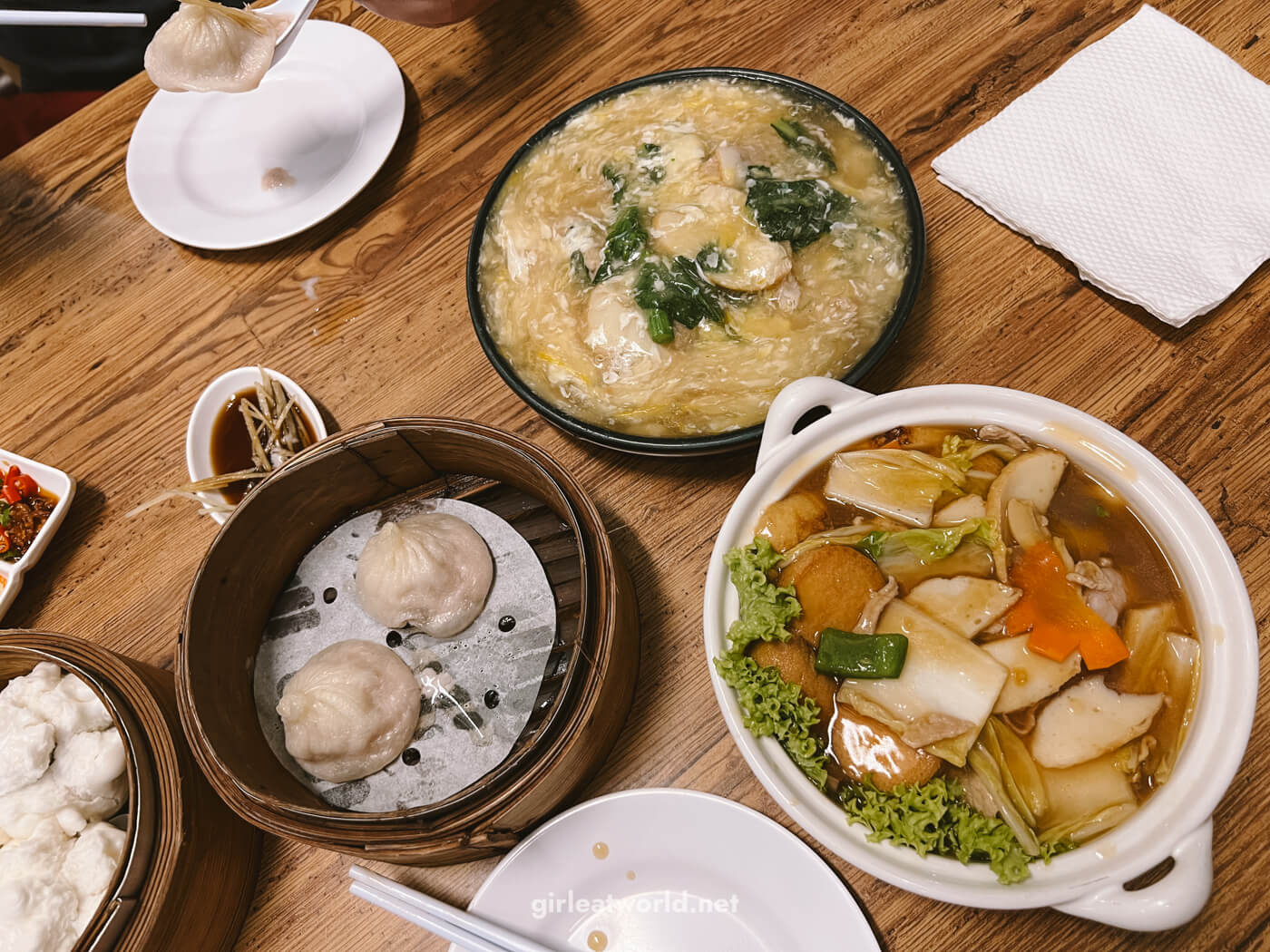
However, in Singapore, there are also low-key restaurants that serve dim sum at lower price points. And you don’t need to have it for breakfast! These restaurants are open late well into the night, making it a popular choice for after-drink sessions.

My favorite dishes to get here is the fish hor fun, char siew bao (pork bun), chee cheong fun (rice rolls), ribs with black bean sauce, claypot tofu, xiao long bao (soup dumpling) and glutinous chicken rice (lo ma gai).
Where to have Dim Sum in Singapore
- Swee Choon Tim House
- Sum Dim Sum
- Dim Sum Haus
- Yum Cha Chinatown
19. Min Jiang Kueh (Peanut Pancake)
Peanut Pancake is a popular snack in Singapore. Traditionally, it is a thick pancake folded in half and stuffed with grated peanuts. The pancake is chewy and moist, making it a nice contrast to the crunchy peanuts!
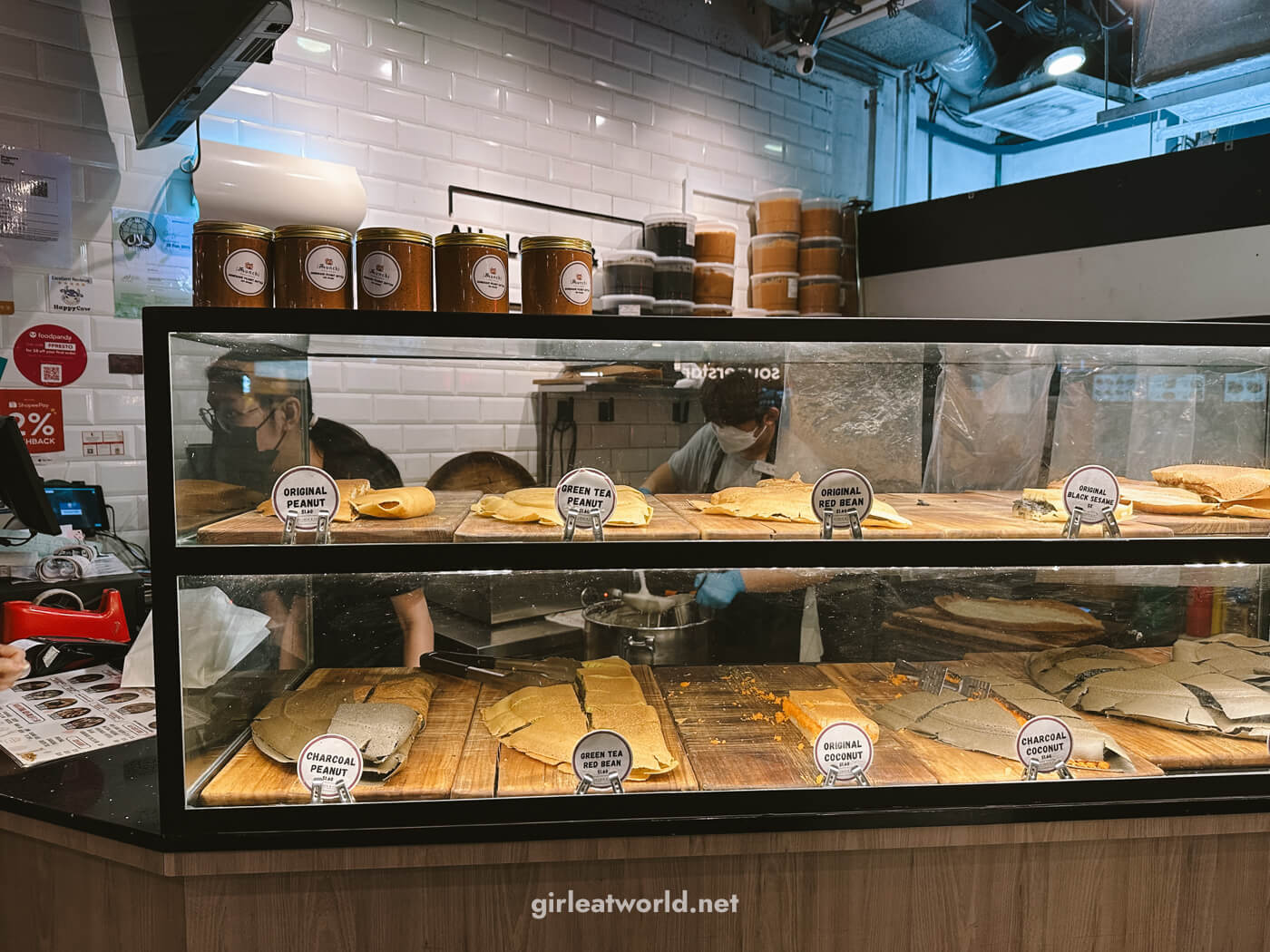
The modernized version of Min Jiang Kuah offers flavors like green tea, sesame and red beans. Sometimes, the batter also comes in… charcoal flavor.
This might raise an eyebrow to some of you, but the charcoal used here is not the same charcoal you use for barbecueing. Instead, it is activated charcoal. Activated charcoal is believed to have cleansing properties and used to treat food poisoning. Nowadays, it can often found in asian snacks. Taste-wise, activated charcoal is supposed to add a smokey flavor but most of the time it’s quite tasteless to me. It does make for a pretty cool food coloring though!
Where to have Min Jiang Kueh in Singapore
- Tanglin Halt Original Peanut Pancake
- Granny’s Pancake (at Hong Lim near China Town MRT)
- Granny’s Pancake (at Bendemeer Food Center near Boon Keng MRT)
- Ah Lock & Co (near Tanjong Pagar MRT)
- Munchi Pancakes (many branches around Singapore, but there is one at Lau Pa Sat and Old Airport Road)
20. Hainanese Beef Noodles
Beef Noodles in Singapore are a type of noodle served with white rice noodles and topped with generous slices of lean beef cuts and bean sprout. With each bowl ordered, the beef slices are quickly blanched in the broth so that it does not get overcooked. Sometimes, you can choose to have meatballs or various innards like tripe.

Like most other noodle dishes in Singapore, it comes in dry (with thick gravy) or soup versions. I personally like the soup form the best. The broth is light and won’t make you feel terrible even if you finished an entire bowl of it.
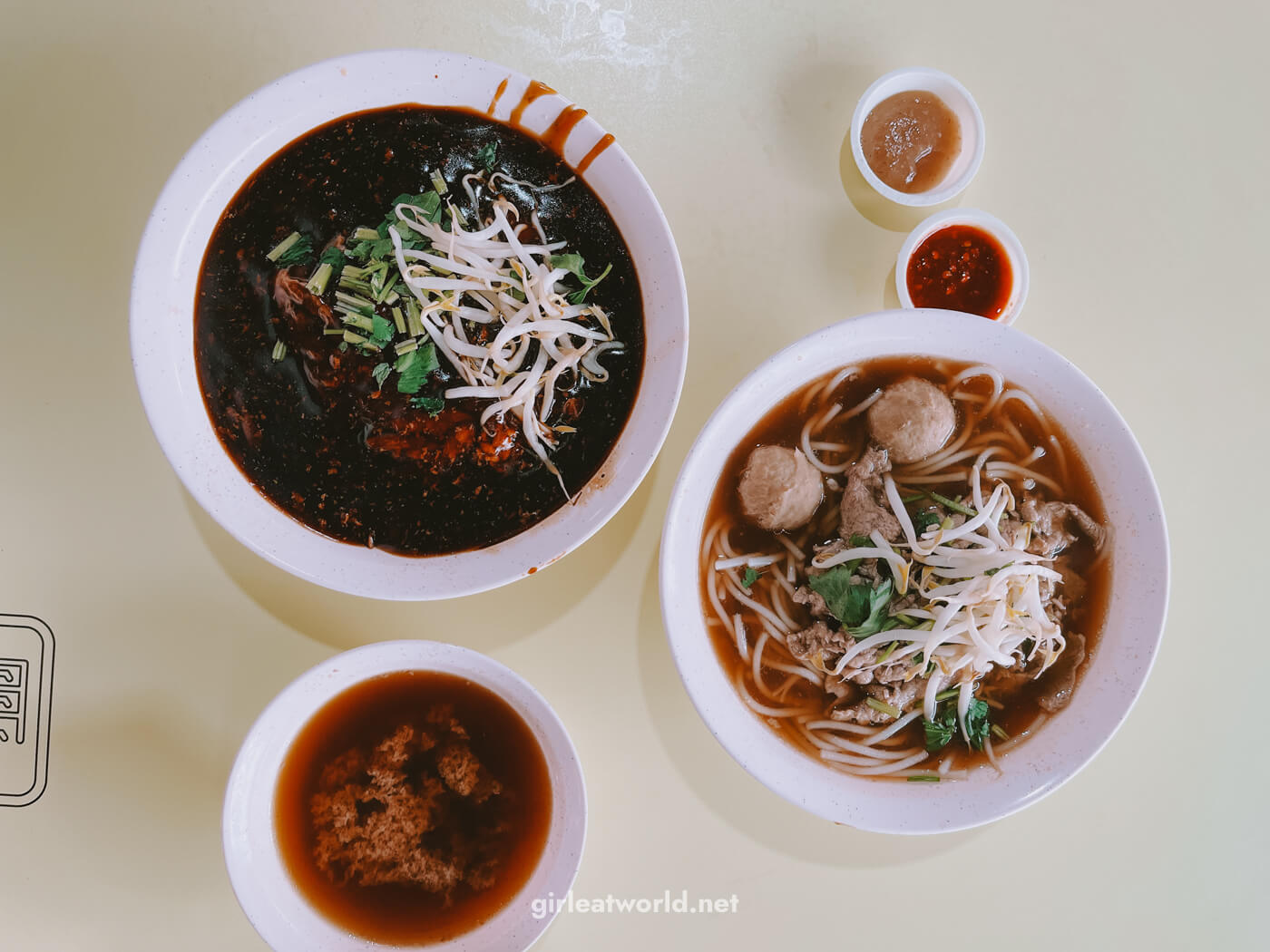
Where to have Beef Noodles in Singapore
- Hwa Heng Beef Noodles (at Bendemeer Food Court)
- Zheng Yi Beef Noodles (in Potong Pasir)
- Hock Lam Beef Noodles (near Raffles Place MRT)
21. Cai Png (Mixed Vegetable Rice)
Mixed vegetable rice, or as I like to call it – point-point rice, is a staple in every Singapore food center. This is a stall that serves an array of cooked dishes, mainly vegetables stir fry or tofu, and some meat (chicken, fish, or beef).
The way it works is as you join the line, a plate of white rice (sometimes red or brown rice) would be scooped up for you. Then you can scan the cooked dish kept in trays behind a glass partition and point to whatever side dish you want to eat with your rice! Hence the nickname point point rice. As you point, the dish would be added to your plate until you’re happy with your choice.
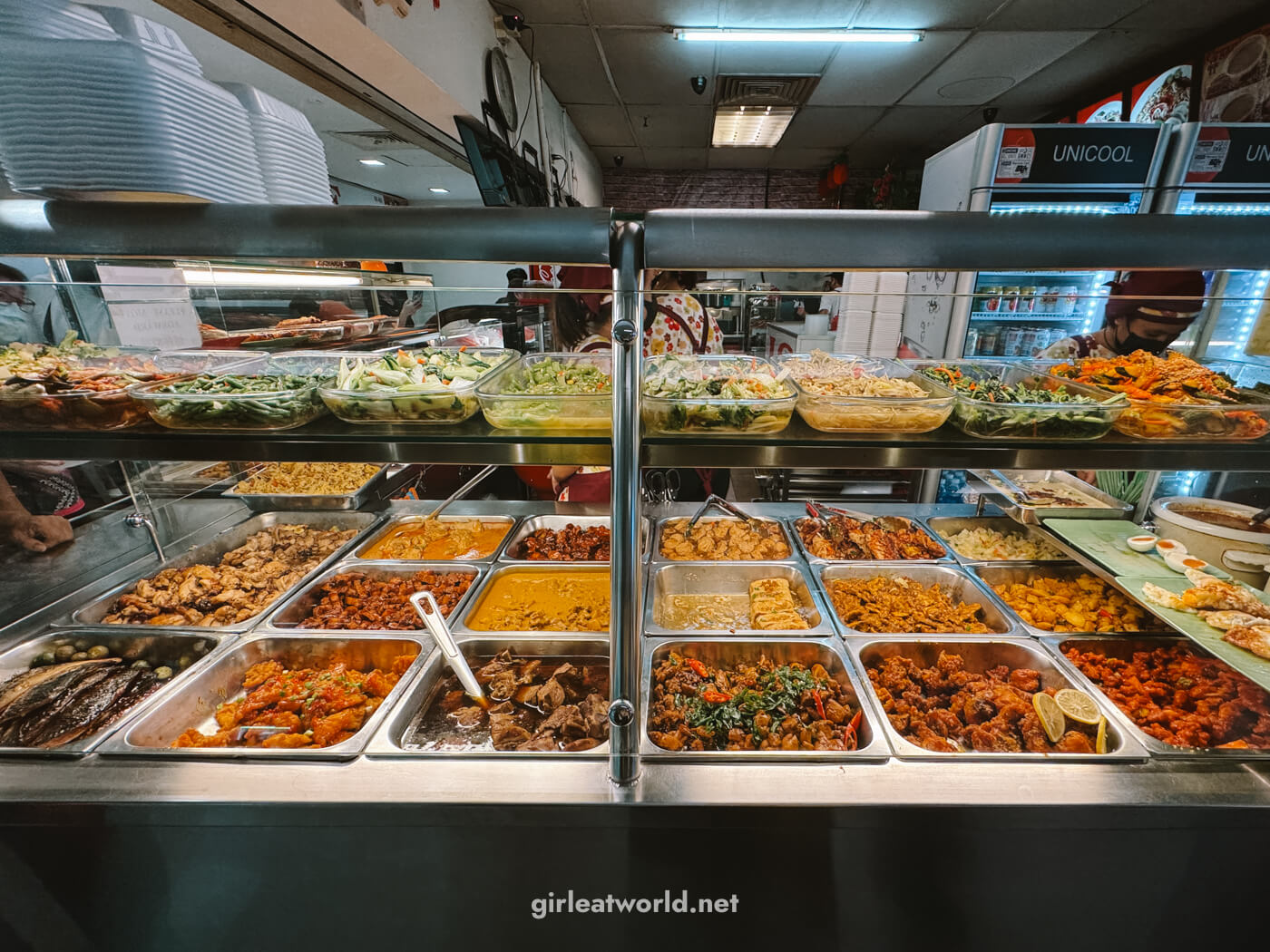
Like Yong Tau Foo, the price depends on how many side dishes you’ve chosen and whether the side has meat or not. I recommend choosing two vegetable sides and one side with meat for a fulfilling meal that still costs only S$5. This type of stall is also known as economy rice, due to how cheap it is relative to other food in Singapore.
The stalls are typically only open on weekdays lunch, as they serve office workers.
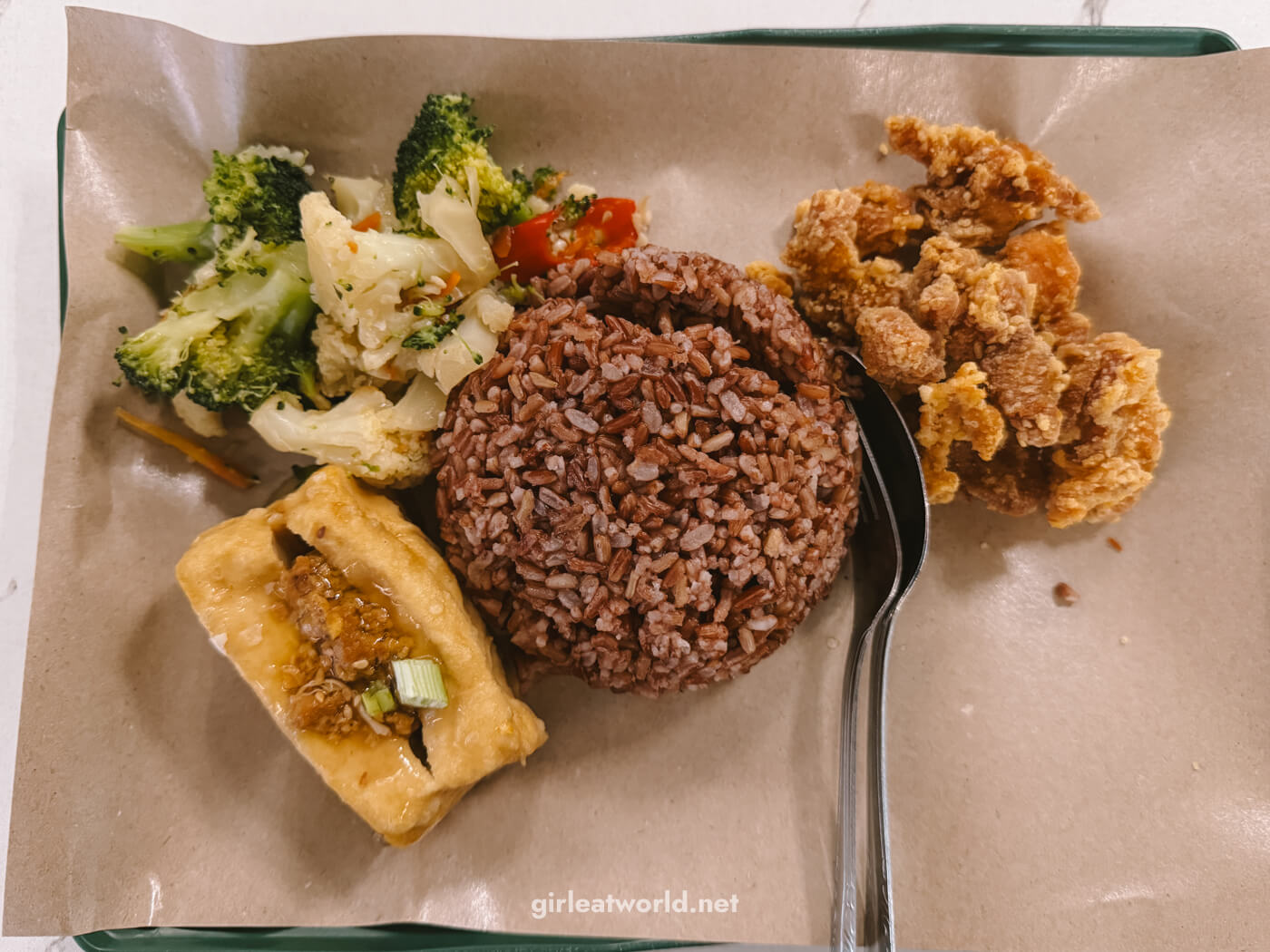
Where to have Cai Png in Singapore
Any food center in Singapore would typically have a stall serving cai png, but there are a few of my favorites:
- Amoy Street Chinese Cuisine at Amoy Street Food Center (Stall #01-16) – My favorite stall when I was working nearby. Their fried chicken is made fresh, but it’s a lottery whether you’ll get it or not. They get long line during lunch hour.
- Isle Cafe at Cuppage Plaza (near Somerset MRT) – Cash only, gets very busy once 12 PM hits. 2 veggie sides and one meat was S$5.
22. Chee Cheong Fun (Rice Noodle Rolls)
It may not look like much, but Chee Cheong Fun is one of the things that, if it’s placed in front of me, I would not be able to say “no” to. At its core, this Cantonese dish just a thin sheet of steamed rice dough, rolled and served with soy sauce, chili sauce, green onion, and sesame sauce.
The result is a silky-smooth dish, perfect to fill up your tummy in the morning. Chee Cheong Fun is usually part of a dimsum, but in Singapore you can find stalls that specialize in just selling Chee Cheong Fun, along with rice porridge.
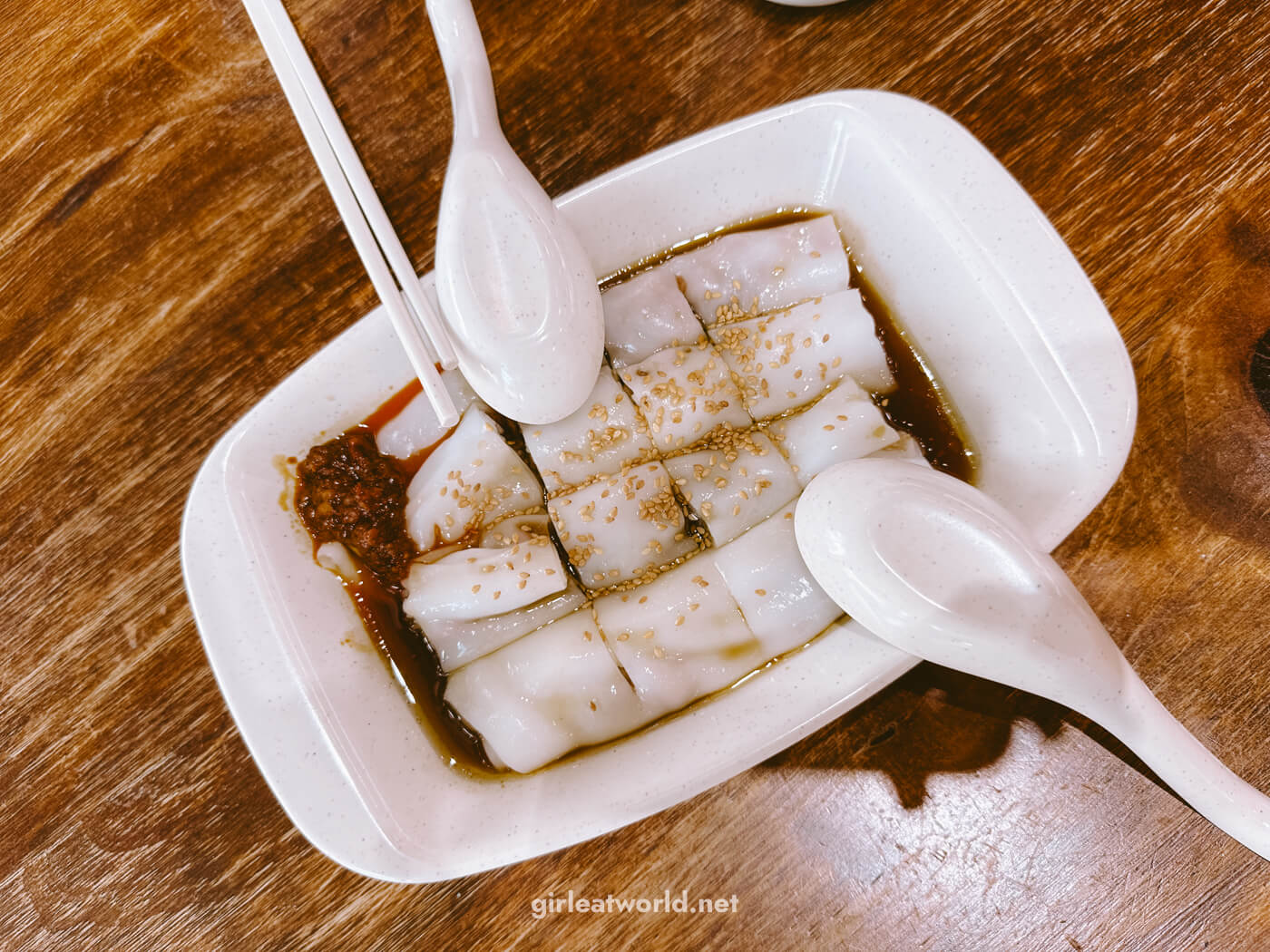
There are a few other variations of Chee Cheong Fun, such as rolling fried you tiao (chinese donuts) into the steamed rice paper, or putting char siu or prawn as a filling. For me, the best one is still the original plain one with nothing inside.
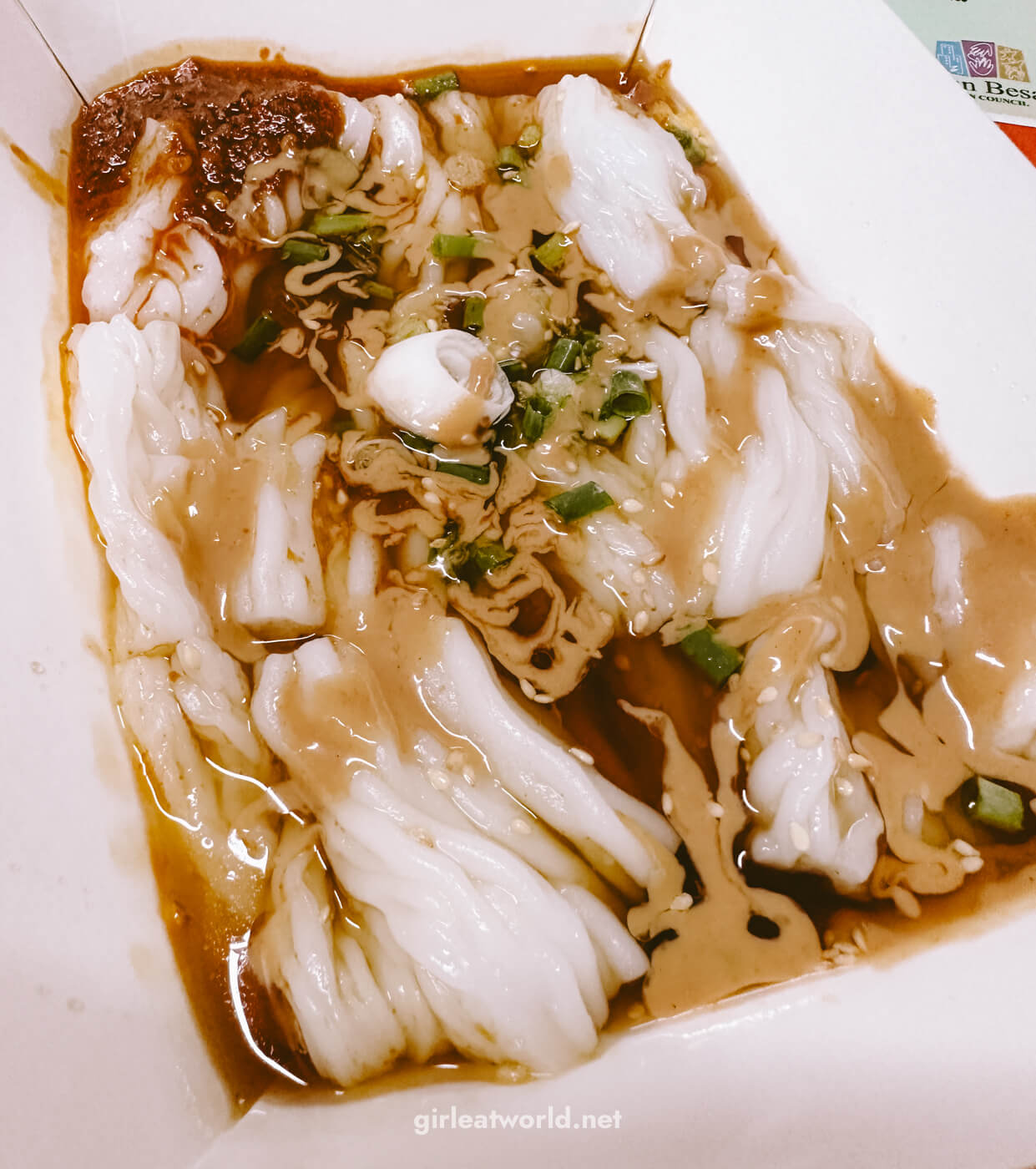
Where to have Chee Cheong Fun
- Nan Rong Chee Cheong Fun (at Bendemeer Food Center near Boon Keng MRT)
- Chef Leung’s Authentic Hand-milled Rice Noodle Rolls (at Chinatown Complex Food Center)
- Fei Chang Hao (near Kallang MRT)
23. Cantonese Roast Meat Rice
If you go to a hawker center and you see a stall with meat hanging in a glass window, you’re in for a treat. These roast meats are originally Cantonese, but you’ll commonly find them in Singapore as well.
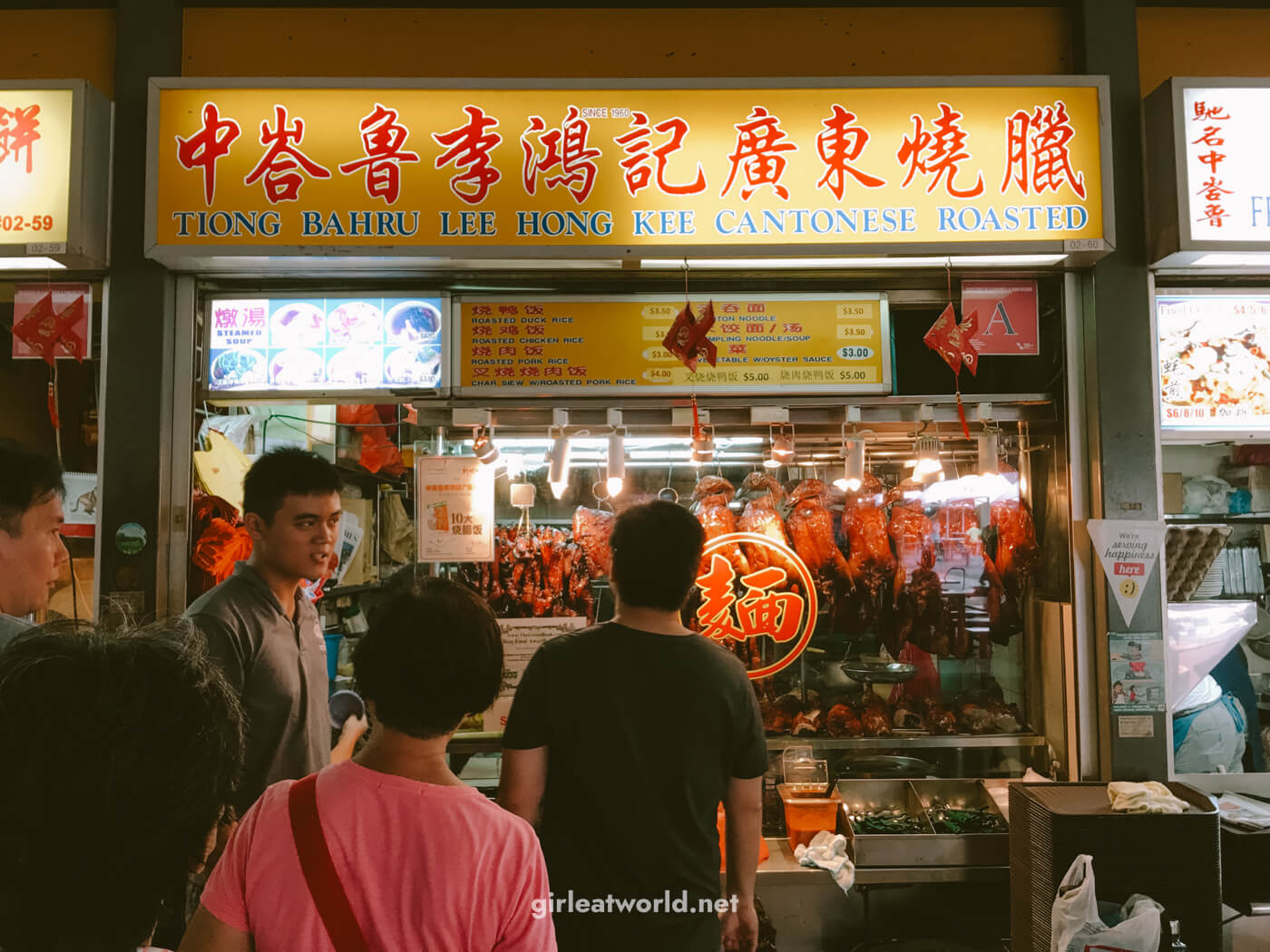
Usually, they serve three types of charcoal-roasted meat: roast meat (roasted pork with crunchy skin), Char siu (marinated sweet BBQ pork), and roasted duck. It would usually be served in either regular or large size, with rice or noodles, and served with slices of fresh cucumber.


And of course, don’t forget the sour chili sauce to dip the meat into!
Where to have Roast Meat Rice
- 88 Hong Kong Roast Meat (at Lavender Street)
- Lee Hong Kee Roast Meat (at Tiong Bahru Market)
24. Nasi Padang (Halal-friendly)
Padang is a city in West Indonesia, and its cuisine is famous all around the country for its spiciness and rich flavors. Although as an Indonesian I wouldn’t say the Padang cuisine that you find in Singapore is authentic, I still think they’re delicious!
In Singapore, Nasi Padang is served similarly to Cai Png or point point rice. Here, Nasi Padang is essentially a plate of white rice with a bunch of side dishes you can choose from. But when you dine in an authentic Padang restaurant in Indonesia, you simply sit at a table and a waiter will bring all the dishes in a small plate. You eat only what you want and you only get charged what you eat. I suppose, the Singapore way is more hygienic.
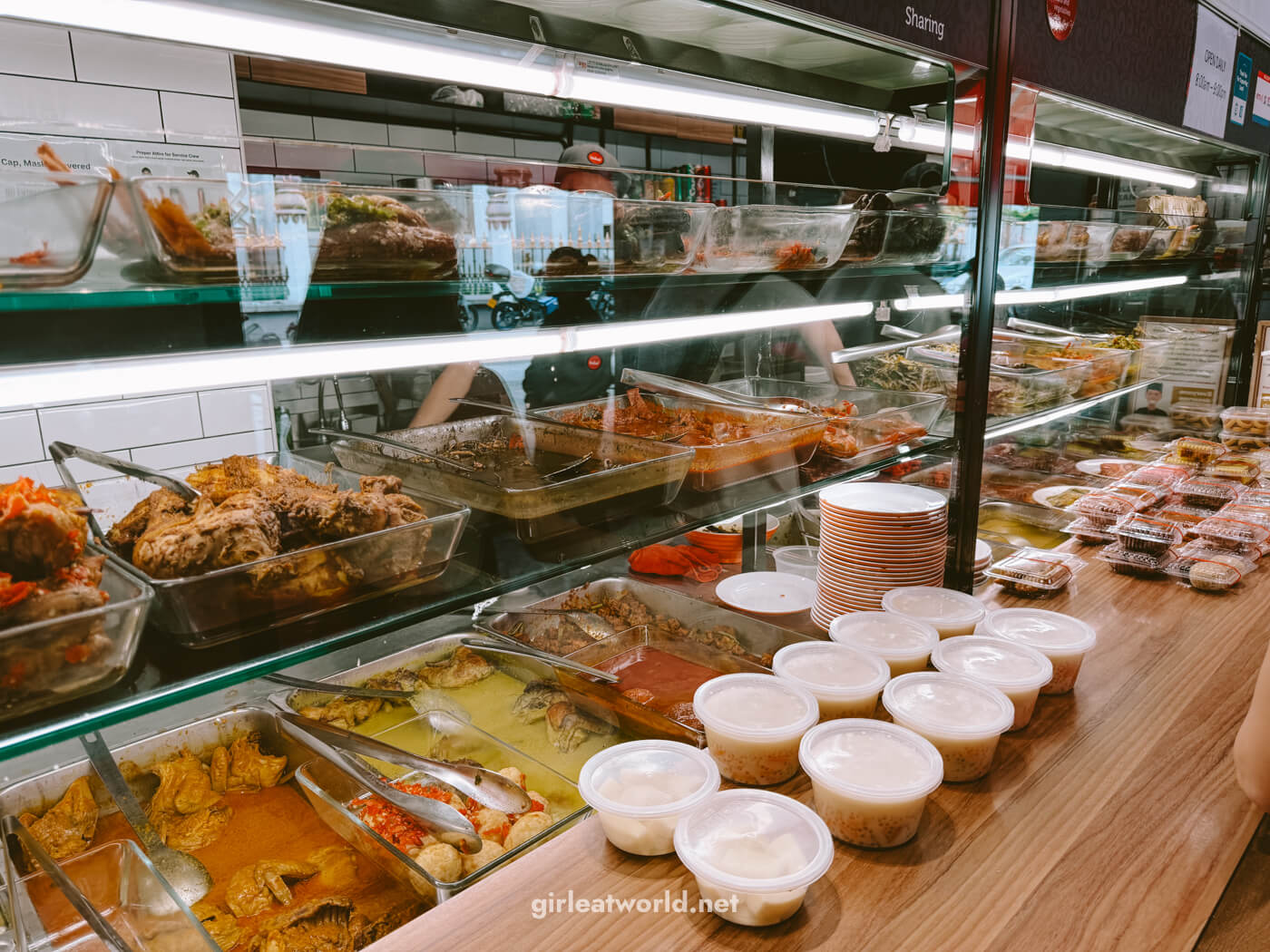
My favorite sides to get at a Padang restaurant are Beef Rendang (Coconut Beef Curry), Bergedil (Potato fritters), and Sambal Kangkong (Spicy water spinach). And if you see Dendeng (Crispy beef), you must try it too!
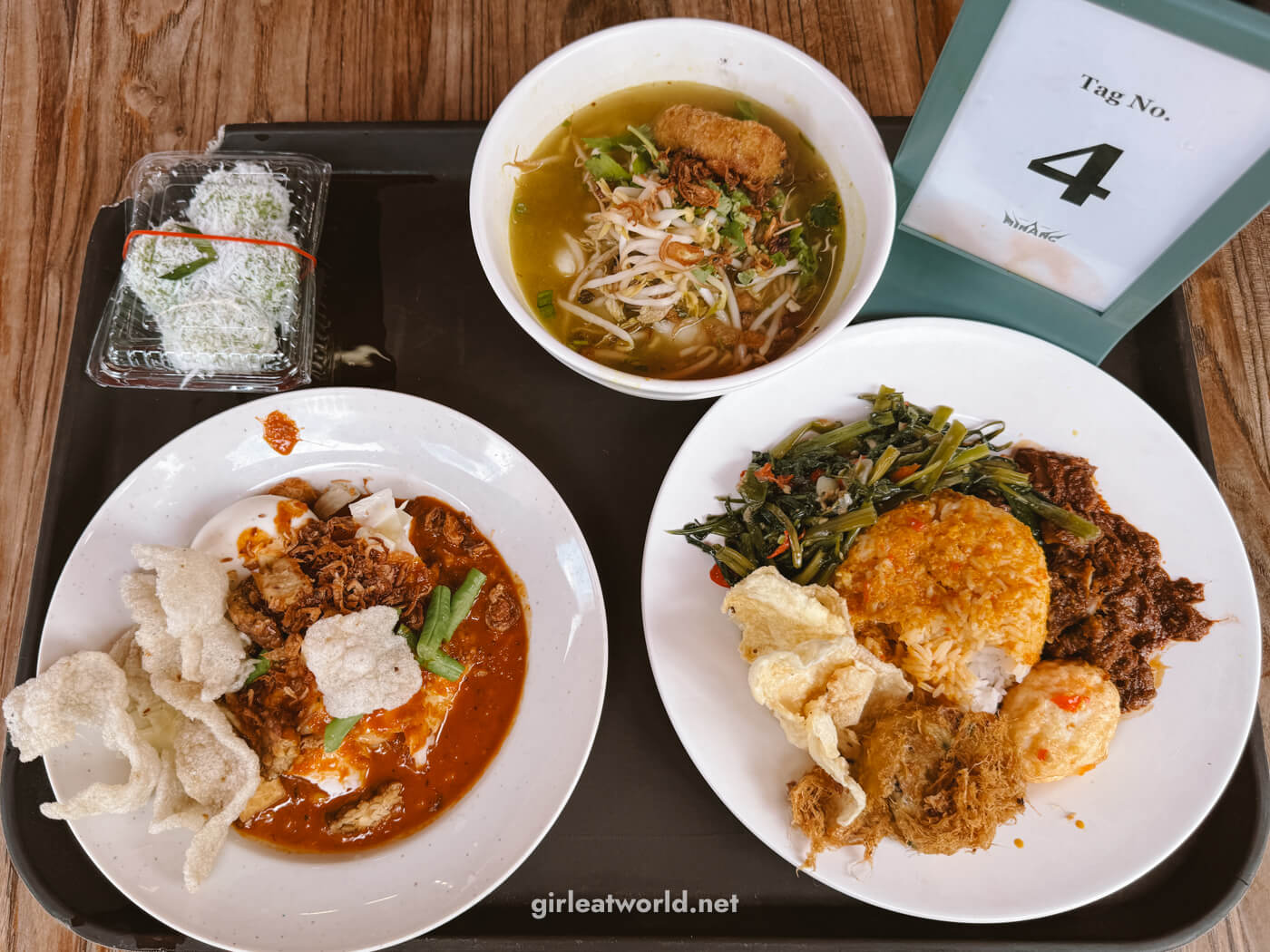
Where to have Nasi Padang
- Rumah Makan Minang (near Bugis MRT)
- Coba Kedai Kopi (near Farrer Park MRT)
- Putra Minang Restaurant (in Bencoolen)
- Nasi Padang Sabar Menanti (near Bugis MRT)
25. Sliced Fish Soup
Sliced fish soup is a Teochew dish that has become a staple of Singaporean food centers. Like many other dishes mentioned in this post, it is exactly what the name said it is – a light noodle soup with sliced chunks of blanched fish, silky tofu, and tons of veggies – usually cabbage and tomatoes. The bowl is topped with seaweed and crispy shallots.
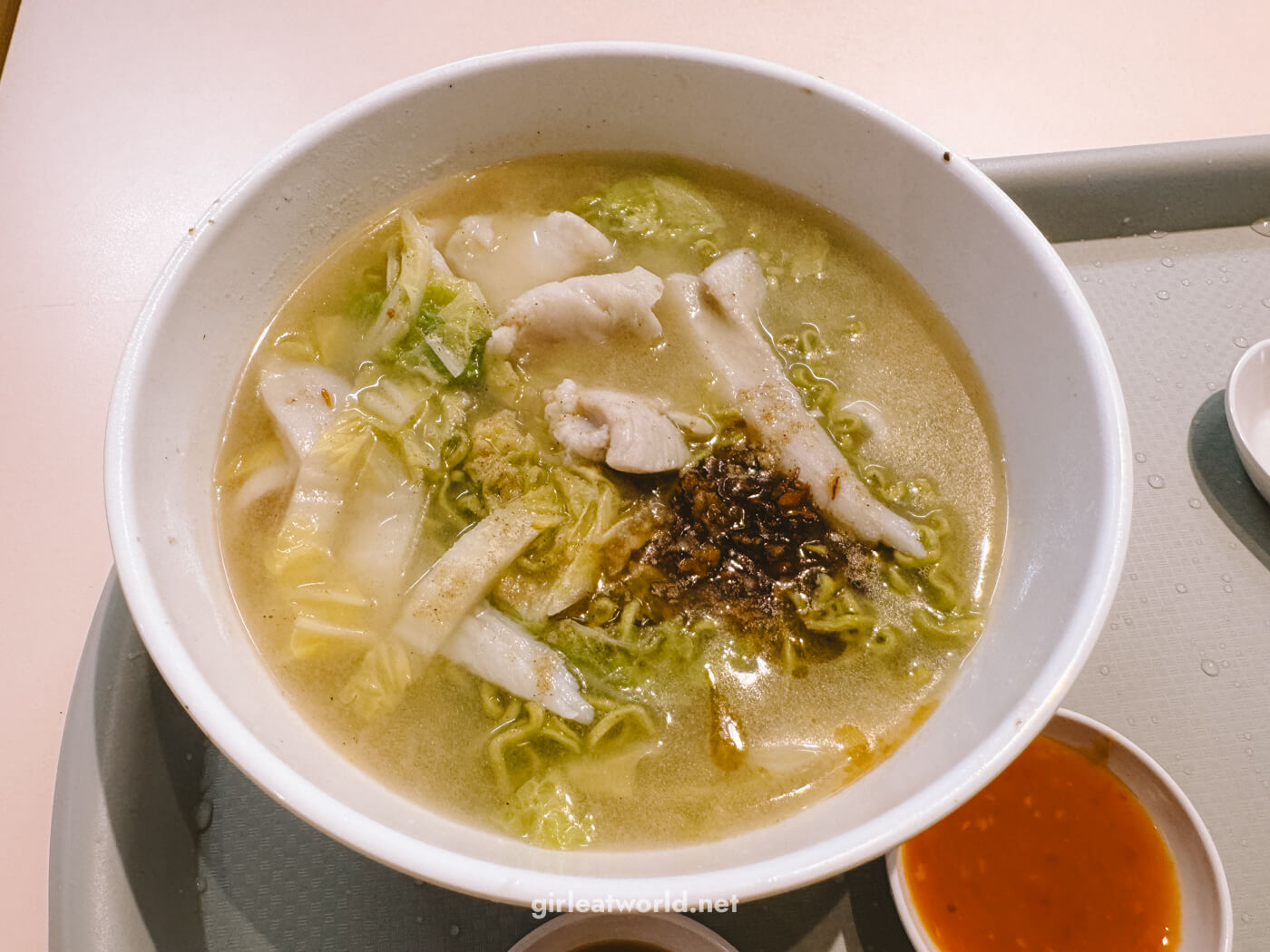
It is considered one of the healthier options in food centers, but fear not, you have the option to make it unhealthy too! The fish could be fried and battered. If that’s still not enough for you, there is a surprise ingredient in fish soup – You can ask for the soup “with milk” and a dash of Carnation milk (evaporated milk) will be added to your soup to make it creamy. The fish used differs from stall to stall, but it is usually Mackarel or Sole.
Where to have Sliced Fish Soup
- Jun Yuan House of Fish at Old Airport Road Food Center
- Han Kee Fish Soup at Amoy Street Food Center
- Tai Seng Fish Soup near Macpherson MRT
- Hua Ji Sliced Fish Soup at Orchard Road
26. Fishball Noodle
This one’s another crowd favorite. Typically served with thin noodles topped with sliced fishcakes and fishballs that are “bouncy” (or as locals like to say, “qq”) in texture, they serve as a comfort food in Singapore. You can find it in nearly every food court and hawker center here.
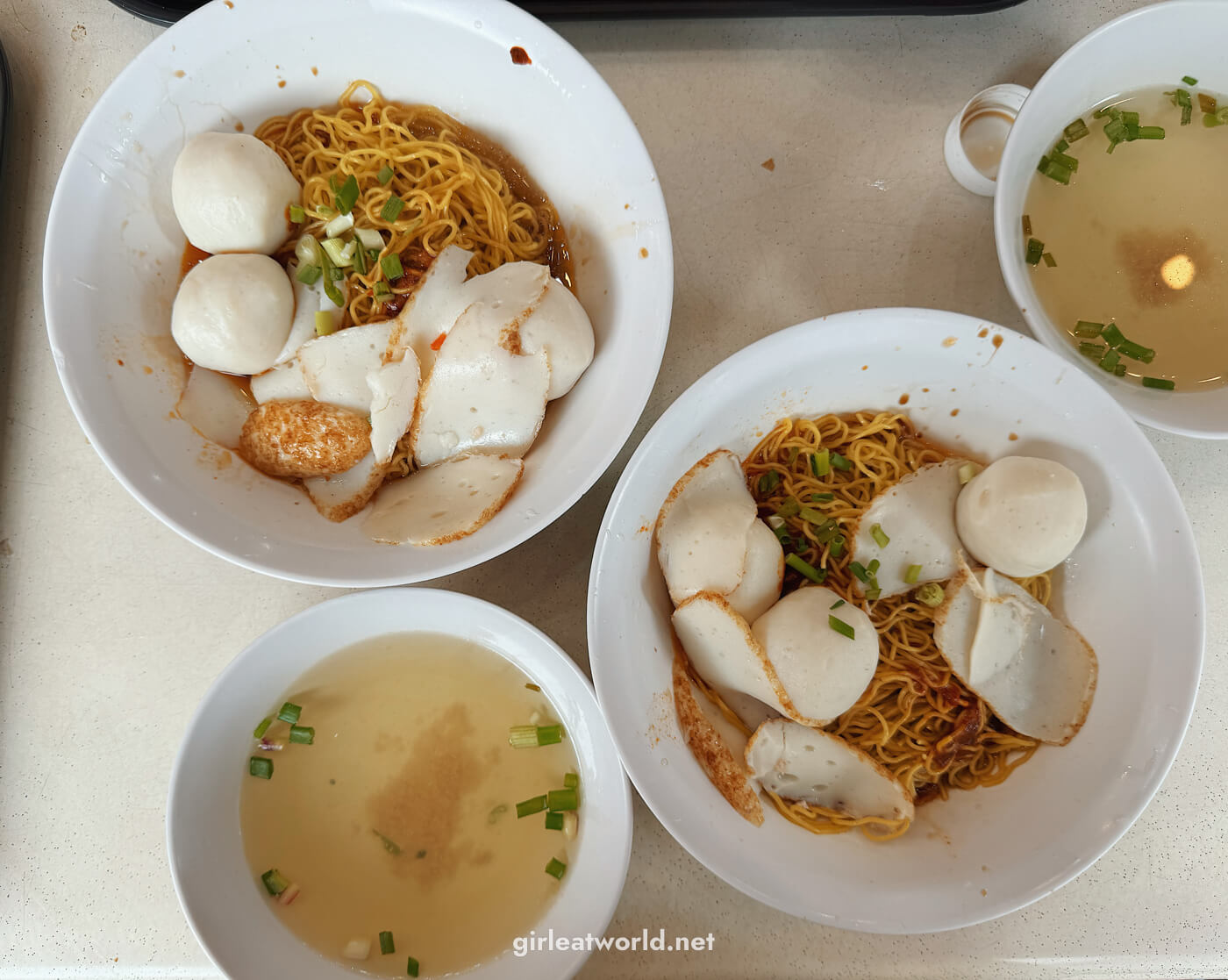
Where to have Fishball Noodles
- Seng Huat Bak Chor Mee (near Bugis MRT) – Famous for Bak Chor Mee, but their Fishball Noodles were just as good!
- LiXin Teochew Fishball Noodles (there is a few branches around town, but the original one is at Toa Payoh) – Awarded Michelin Bib Gourmand for their delicious noodles!
27. Beef Horfun
Horfun is a cantonese flat wide rice noodle. It’s known across many asian countries, but in Singapore, it exists mainly as Beef Horfun – a gravy-filled noodle dish served with thin slices of beef and the same flat white noodles.
What makes the dish so good lies in the preparation – the noodles in Beef Horfun are wok-fried separately than the gravy, to give it a nice, smokey “wok hei” taste. The beef slices are velveted using the classic asian restaurant method (using baking soda) then pan seared. The gravy is then cooked on the same pan.

Beef Horfun is typically eaten with pickled green peppers.
They say you shouldn’t judge book by its cover, and that applies to food too. Beef Horfun isn’t the most appetizing meal when you look at it, but it is so delicious. One of my favorite local fare!
And if like me you’re a fan of the wide rice noodle, there are a few other dishes that uses horfun and often found in Singapore – seafood horfun, san loh (sliced fish) horfun, and moonlight horfun (egg yolk). However, they all use different sauces and cooking technique, which results in very different dishes.
Where to have Beef Horfun
- Chatterbox – They’re a hotel restaurant located at the fancy Hilton Singapore, and known for their chicken rice, but I actually really enjoyed their horfun.
- Good Day (at Amoy Street Food Center Stall #01-25)
Phew, that was the longest food guide ever written in this blog. What can I say? I do love my country, and I hope you will have a lot of fun and tasty food when you are here.
Until next time!
Visiting Singapore? Check out my Singapore Travel Guide here

I think its irresponsible to quote so many tourist traps. Once i saw Tian Tian chicken rice from Maxwell, i start to doubt if u are a true local foodie. Meh~
Never said I was a foodie, just that I’m someone who has lived in Singapore for almost two decades 😆 so feel free to doubt.
In regards to the rest of your comment, I don’t have much else to say. I don’t know what you have against Tian Tian since you don’t elaborate in your short and dismissive comment~
Beautifully written!!!
Now the point point rice is no longer economical, 2 dishes of vegetables and a meat can easily set you back by $6-$8 or even $10.
You mentioned the price of some dishes,but particularly you should mention it’ll cost you a arm to eat chilli crab
Hey Robin, that’s a great point – I should add the prices for the food items!